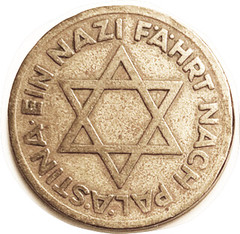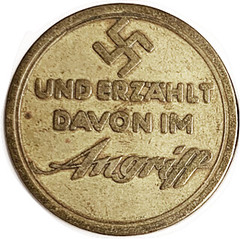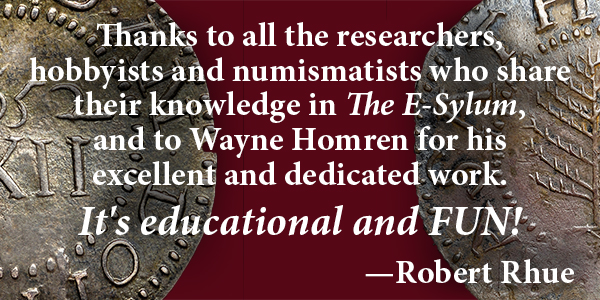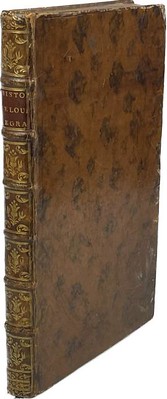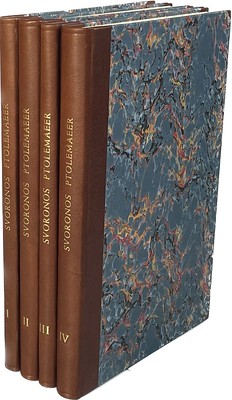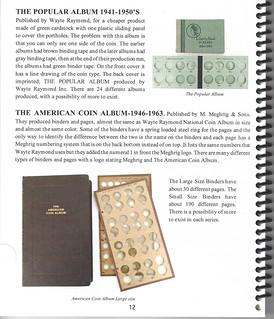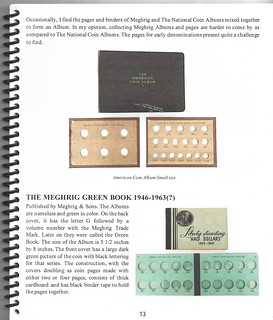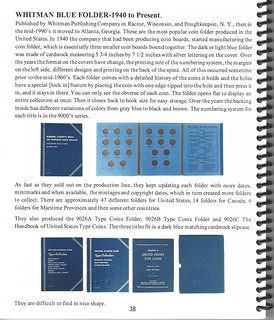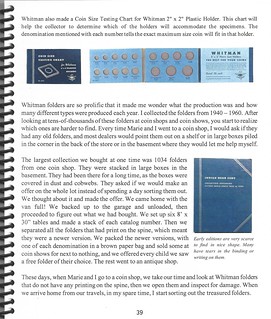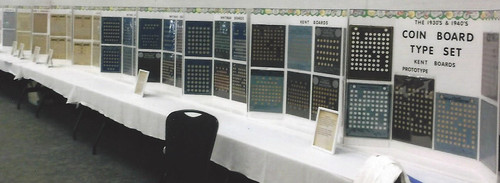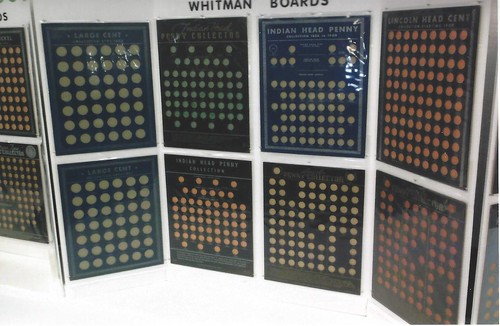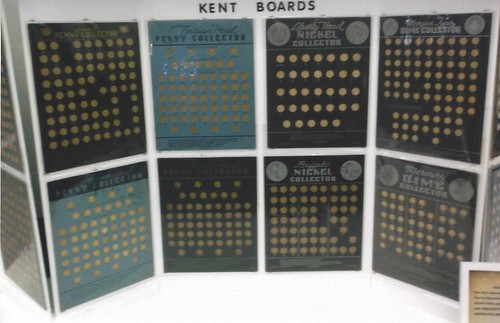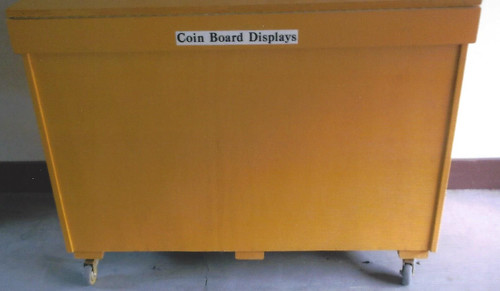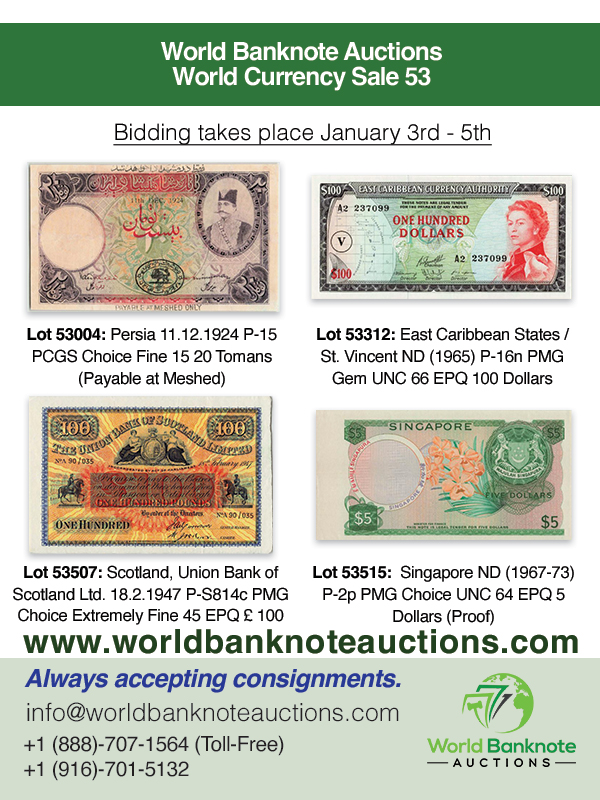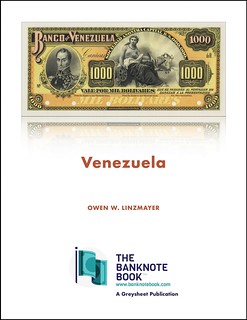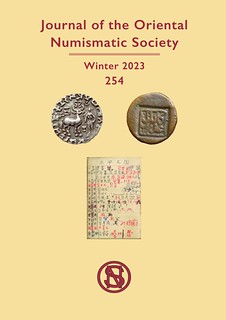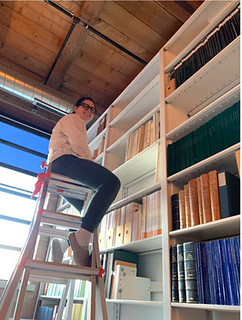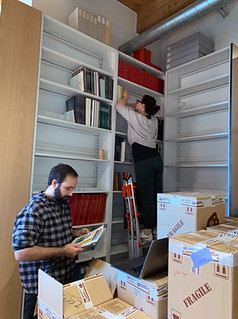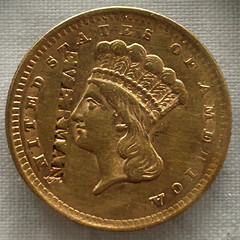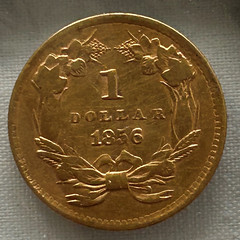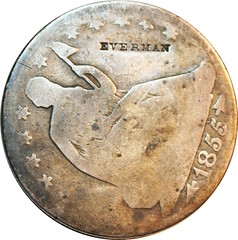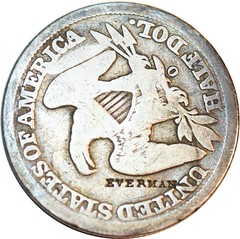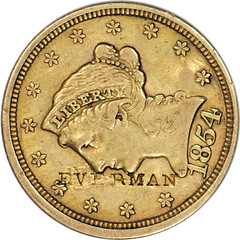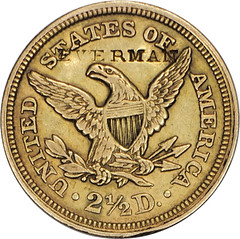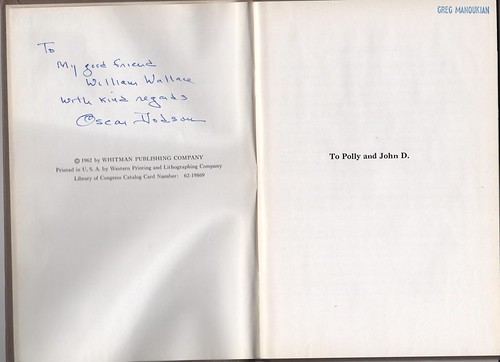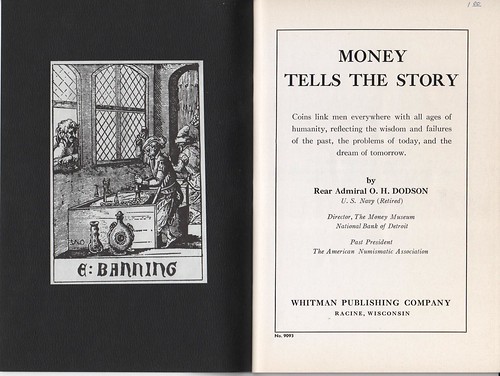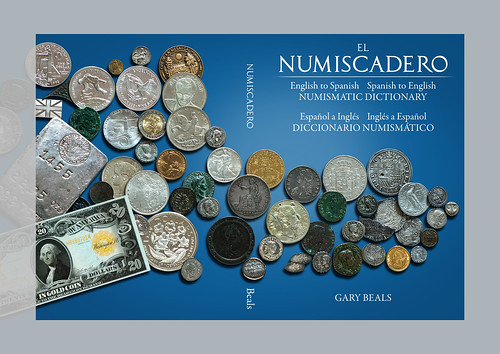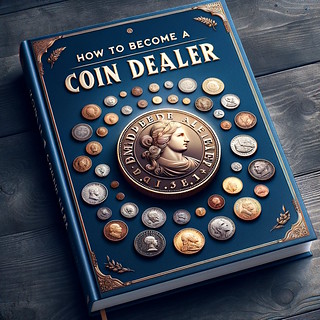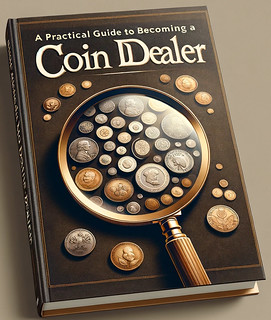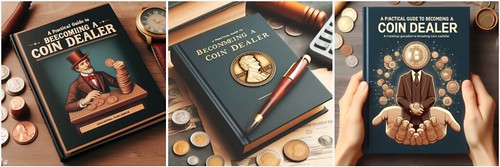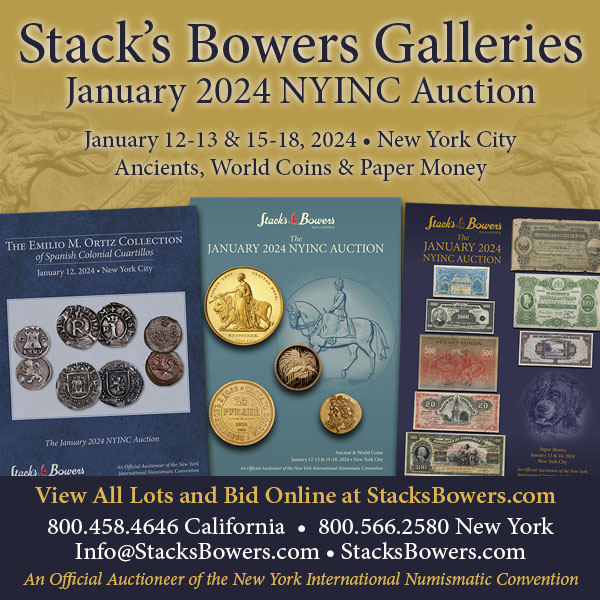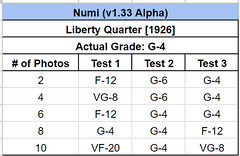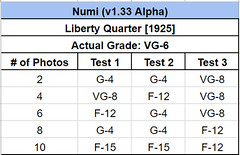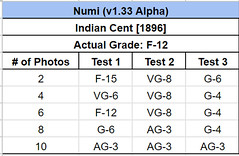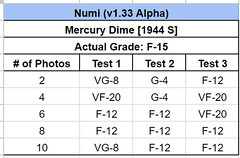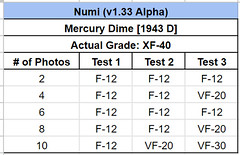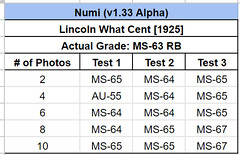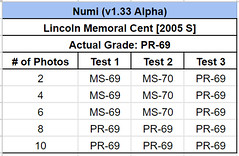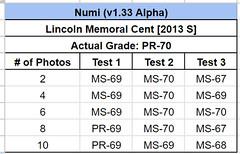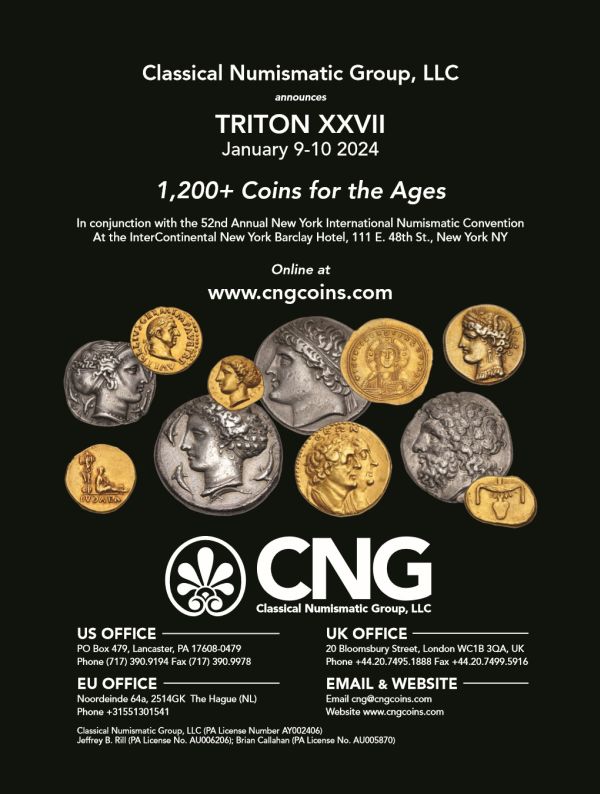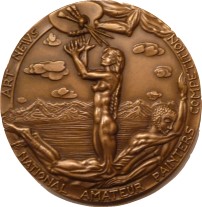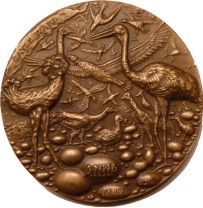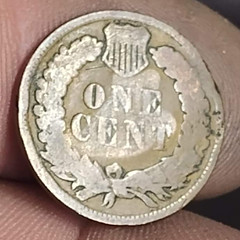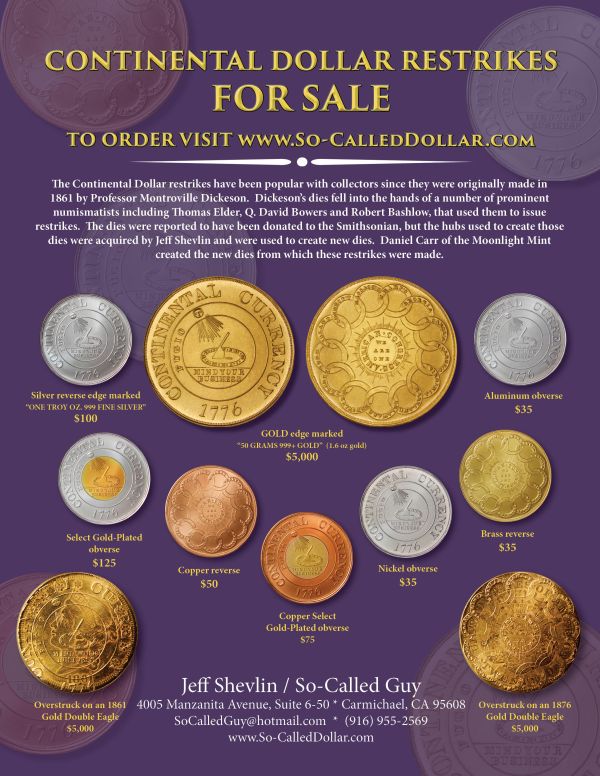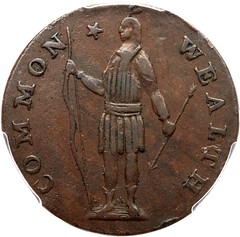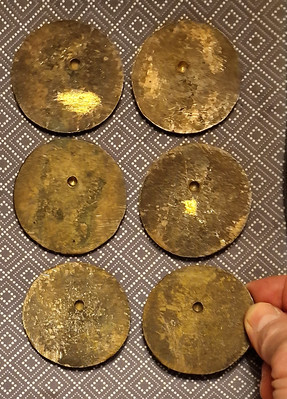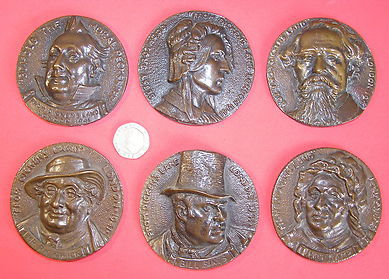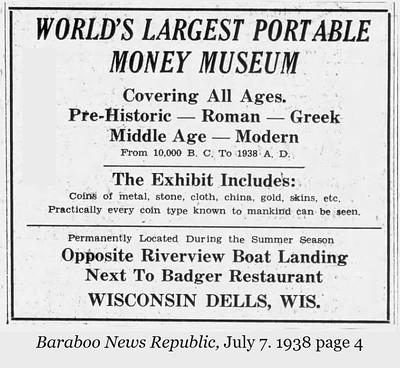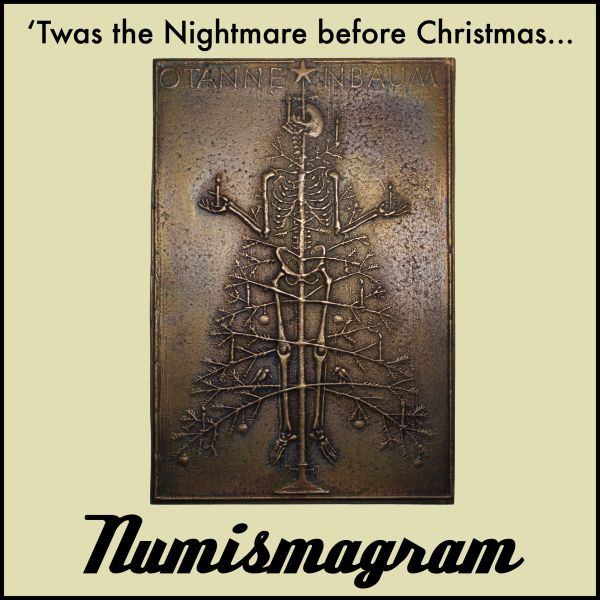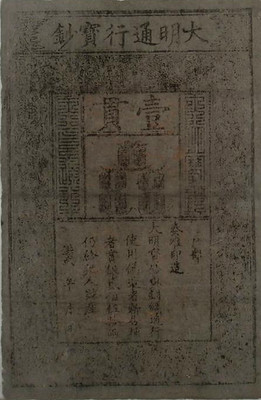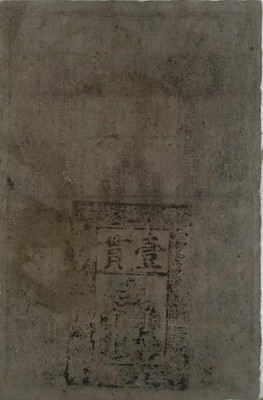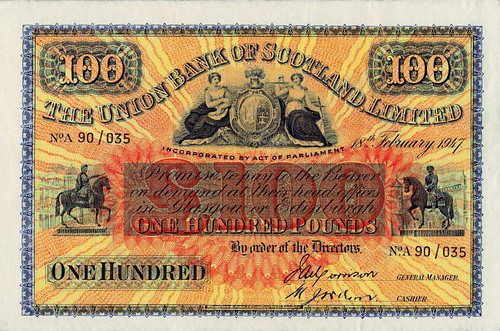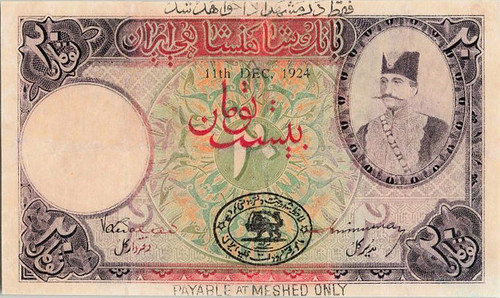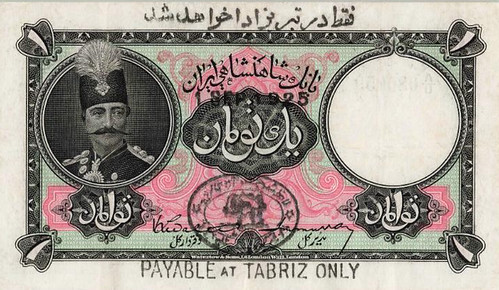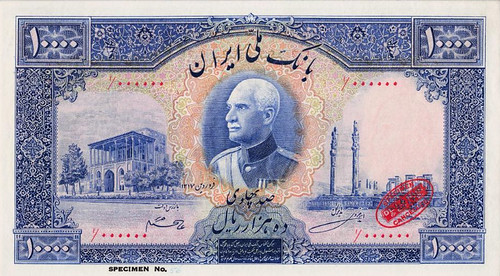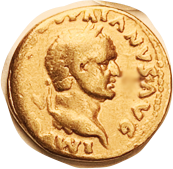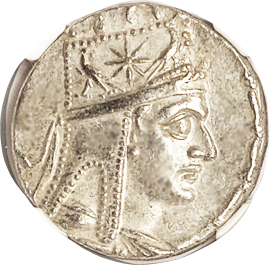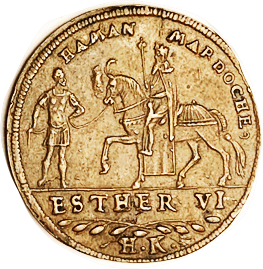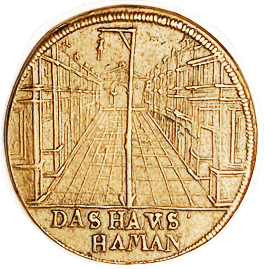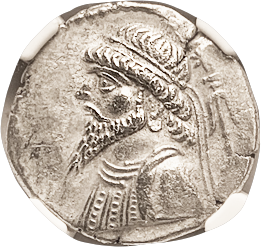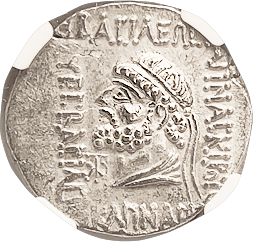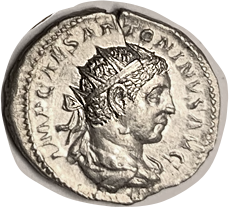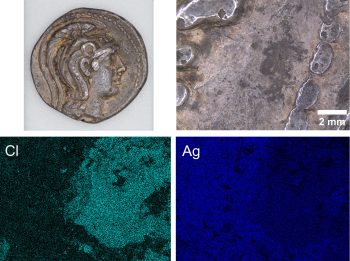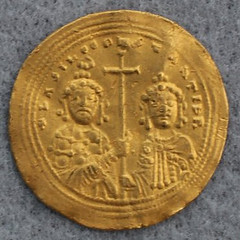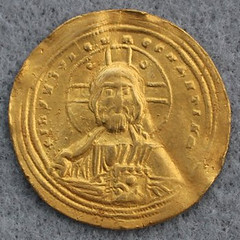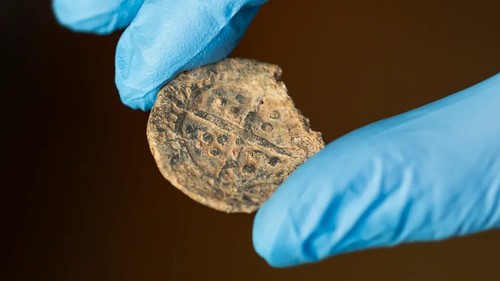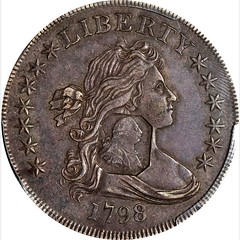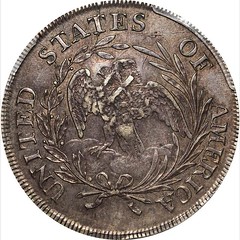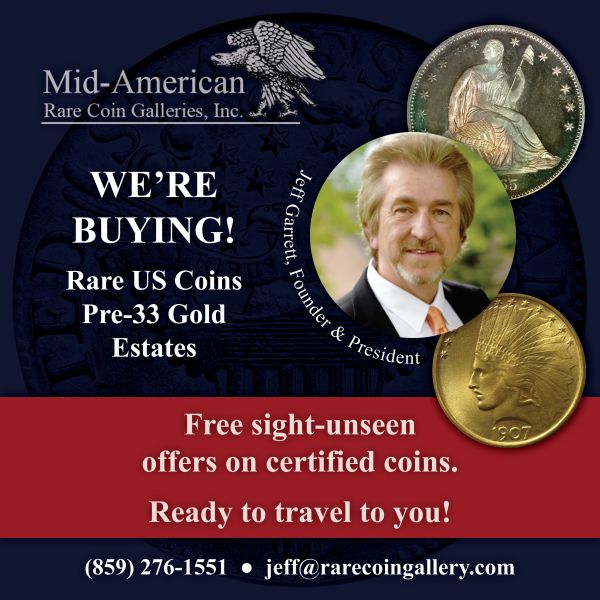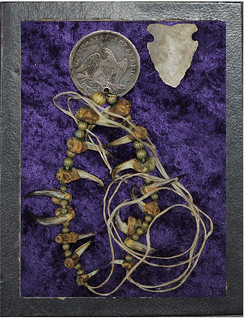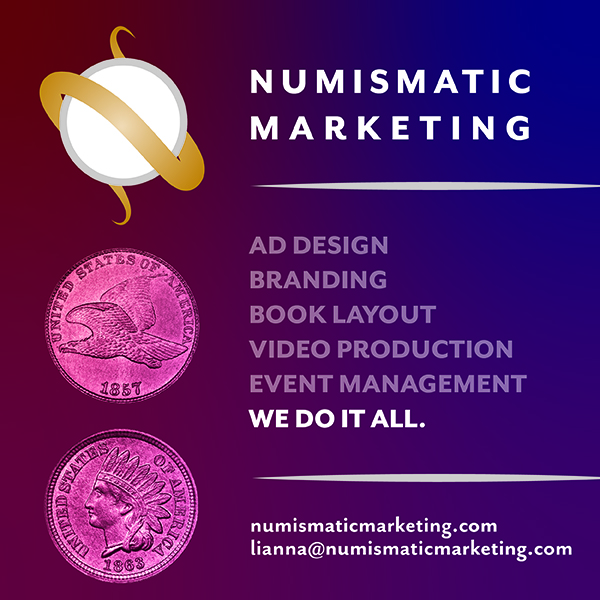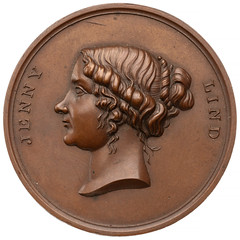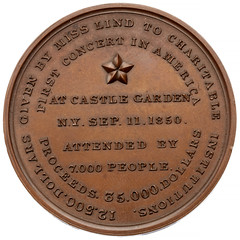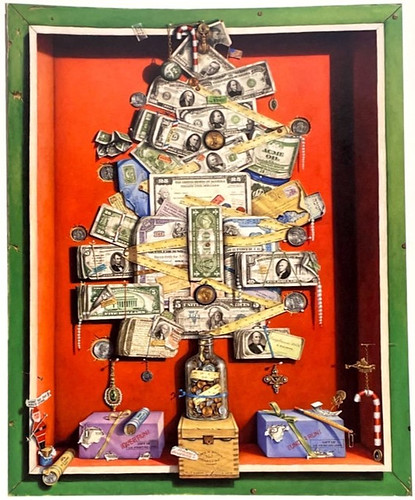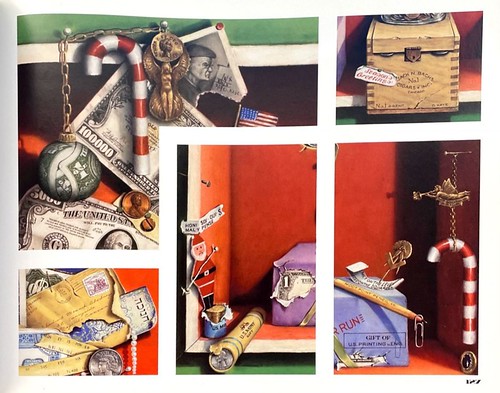
Visit our NBS Sponsors
About UsThe Numismatic Bibliomania Society is a non-profit association devoted to the study and enjoyment of numismatic literature. For more information please see our web site at coinbooks.org SubscriptionsThose wishing to become new E-Sylum subscribers (or wishing to Unsubscribe) can go to the following web page link MembershipThere is a membership application available on the web site Membership Application To join, print the application and return it with your check to the address printed on the application. Print/Digital membership is $40 to addresses in the U.S., and $60 elsewhere. A digital-only membership is available for $25. For those without web access, write to: Jeff Dickerson, Treasurer AsylumFor Asylum mailing address changes and other membership questions, contact Jeff at this email address: treasurer@coinbooks.org SubmissionsTo submit items for publication in The E-Sylum, write to the Editor at this address: whomren@gmail.com BUY THE BOOK BEFORE THE COINSale Calendar |
- WAYNE'S WORDS: THE E-SYLUM DECEMBER 24, 2023
- NUMISMATISCHES ANTIQUARIAT LANG AUCTION 1
- NEW BOOK: COLLECTING VINTAGE COIN BOARDS 3RD ED
- BANKNOTE BOOK VENEZUELA CHAPTER PUBLISHED
- ORIENTAL NUMISMATIC SOCIETY WINTER 2023
- REXFORD ADDISON STARK (1947-2023)
- BCD CATALOGS ARRIVE IN CHICAGO
- MORE ON THE EVERMAN COUNTERSTAMP
- VIDEO: 1715 FLEET SOCIETY 2017 CONFERENCE
- MORE ON THE MONEY MUSEUM
- AI-GENERATED COIN BOOK COVERS
- UPDATE: AI-POWERED APP NUMI
- NOTES FROM E-SYLUM READERS: DECEMBER 24, 2023
- ACQUIRING A 1788 R 4-G MASSACHUSETTS CENT
- DICKENS LAND LONDON 1941 MEDALS
- VOCABULARY TERM: OVERSIZE FLAN
- FREDERICK WILLIAM HARRIS (1872-1938)
- WBNA WORLD CURRENCY SALE 53
- FRANK S. ROBINSON 123ND AUCTION
- ROYAL ONTARIO MUSEUM'S ROMKOMMA PROJECT
- BYZANTINE COIN FIND IN NORWAY
- MEDIEVAL CHURCH CHRISTMAS TOKEN FOUND
- BANK OF ENGLAND COUNTERSTAMP ON 1798 DOLLAR
- 1859-O DOLLAR IN INDIAN TRADE NECKLACE
- 1920 ZANZIBAR 1 RUPEE SPECIMEN NOTE
- ISRAEL DROPS FAKE MONEY ON GAZA
- THE KING OF SILENT ANIMATION
- THE $100,000 GOODWILL STORE VASE
- THE WILD RIDE OF COLLECTIBLES
- JENNY LIND AND
SWIFT-MANIA
- LOOSE CHANGE: DECEMBER 24, 2023
- OTIS KAYE'S HOLIDAY TREE OF MONEY
Content presented in The E-Sylum is not necessarily researched or independently fact-checked, and views expressed do not necessarily represent those of the Numismatic Bibliomania Society.
WAYNE'S WORDS: THE E-SYLUM DECEMBER 24, 2023
 New subscribers this week include:
Don Ackerman, courtesy of Alan Weinberg, who writes, "Don is head of Heritage's historical / political dept and has been an authority and serious collector of political ephemera for decades and co-founder with
the late Jon Mann of The Railsplitter which is now online."
Welcome aboard!
New subscribers this week include:
Don Ackerman, courtesy of Alan Weinberg, who writes, "Don is head of Heritage's historical / political dept and has been an authority and serious collector of political ephemera for decades and co-founder with
the late Jon Mann of The Railsplitter which is now online."
Welcome aboard!
Thank you for reading The E-Sylum. If you enjoy it, please send me the email addresses of friends you think may enjoy it as well and I'll send them a subscription. Contact me at whomren@gmail.com anytime regarding your subscription, or questions, comments or suggestions about our content.
As noted earlier, this issue and the next one are arriving late because of the holidays. This week we open with a numismatic literature auction, two new books, a periodical, a library on the move, updates from the Newman Numismatic Portal, and more.
Other topics this week include coin boards, counterstamps, the 1715 fleet, AI in numismatics, Massachusetts cents, oversize flans, Rev. Fred Harris, auction reviews, fake banknotes in Gaza, Jenny Lind and Otis Kaye.
To learn more about Venezuela banknotes, Chinese coin charms, Rex Stark, the BCD library, the Money Museum of the National Bank of Detroit, the Numi app, Charlotte Mint superintendent and chief assayer Stuart Cramer, Dickins Land medals, Russian Cheese Money, Ming dynasty notes, the posthumous Dupondius, the Nazi who traveled to Palestine, and the world's largest portable money museum, read on. Have a great week, everyone!
Wayne Homren
Editor, The E-Sylum
NUMISMATISCHES ANTIQUARIAT LANG AUCTION 1
Here's the announcement for the first numismatic literature auction from Numismatisches Antiquariat Lang. -Editor
 1st auction of numismatic literature at the Numismatische Antiquariat Lang GmbH on January 07, 2024
1st auction of numismatic literature at the Numismatische Antiquariat Lang GmbH on January 07, 2024
Auction 1 of the Numismatisches Antiquariat Lang will offer 1328 lots of numismatic literature on January 07, 2024. The auction begins with a lot of bibliophile works. These include numerous rare books and magnificent volumes. This will be followed by general literature and a wide range of ancient numismatic titles. Three original editions are particularly noteworthy: Svorono's work "Ta Nomismata tou Kratous ton Ptolemaion" in a beautiful uniform half leather (lot 282), Haeberlin "Aes Grave Das Schwergeld Roms" (lot 180) and Ravel "Descriptive catalogue of the collection of Tarentine coins formed by M. P. Vlasto" (lot 250).
Lot 55: Menestrier, C.F. Histoire du Regne de Louis Le Grand. Par les médailles, emblêmes, devises, jettons, inscriptions, armoiries, et autres monumens publics. Paris 1700. Kupfertitel mit Vign., gest. Portr.-Front., gest. Front., 93 Tfn. (2 gefalt.) und zahlr. Textkupfern und Initialen. 80 S., 4 Bll. Contemporary full leather, somewhat bumped and foxed. Splendid edition. Expanded edition of the 1693 edition.
Lot 282: Svoronos, J.N. Ta Nomismata tou Kratous ton Ptolemaion. 4 Bände. Athen 1904-1908. XII S., 506 Spalten, 3 Falttabellen; 324 S.; 64 Tfn.; LXVIII, 622 Spalten, 4 Tfn. Band 4 beinhaltet auf Spalten 1-396 eine umfangreiche Zusammenfassung dieser grundlegenden Studie in deutscher Sprache. Am Schluss verlagsmäßig in separater Paginierung hinzugefügt: HULTSCH, F. Die Gewichte und Werte der ptolemäischen Münzen. 80 Spalten. Athen 1904-1908. Uniformly bound in 4 volumes. Half leather, crease in volume 1.
Splendid copy. Rarely offered in the original.
Literature from the Middle Ages and modern times is most strongly represented. When browsing the selection, you will find numerous standard works in the original edition as well as sought-after and out-of-print works. There are also special editions and fine quality items. Examples include Dannenberg "Die deutschen Münzen der sächsischen und fränkischen Kaiserzeit" in the original (lot 417), Mailliet "Catalogue descriptif des monnaies obsidionales et necessite" in the original (lot 654) and a splendid edition by Chestret "Numismatique de la principaute de Liege et de ses dependances (Bouillon, Looz) depuis leurs annexions" (lot 409).
After a small number of commemorative publications, periodicals come under the hammer. Particularly noteworthy here are a complete series of the Numismatische Zeitschrift Wien and an almost complete series of the Gazette numismatique francaise.
Lot 475: Fiala, E. Münzen und Medaillen der Welfischen Lande. 1. Teil: Prägungen der Zeit der Ludolfinger, Brunonen, Billinger, Supplingenburger etc. Prag 1916. 143 S., 6 Tfn. 2. Teil: Die Welfen in den Sachsenlanden. Das alte Haus Braunschweig. Das alte Haus Lüneburg. Prägungen der Burgundier, der Welfen in Bayern, Italien etc. Prag 1910. 173 S., 11 Tfn. 3. Teil: Das alte Haus Braunschweig, Linie zu Grubenhagen. Mittelbraunschweig-Mittellüneburg. Prag 1906/1907. 112 S., 5 Tfn. 4. Teil: Das mittlere Haus Braunschweig, Linie zu Wolfenbüttel. Prag 1906. 268 S., 19 Tfn. 5. Teil: Das mittlere Haus Braunschweig, Linie zu Calenberg. Prag 1904. 53 S., 4 Tfn. 6. Teil: Das neue Haus Braunschweig zu Wolfenbüttel. Prag 1907/1908. 292 S., 18 Tfn. 7. Teil: Das neue Haus Braunschweig zu Wolfenbüttel II. (Bevern). Prag 1909. S. 295-466, Tfn. 19-27. 8. Teil: Das neue Haus Lüneburg (Celle) zu Hannover I. Prag 1912. 283 S., 14 Tfn. 9. Teil: Das neue Haus Lüneburg (Celle) zu Hannover II. Prag 1913. S. 287-587, Tfn. 15-36. 10. Teil: Das neue Haus Lüneburg zu Hannover III. Prag 1915. S. 591-766, Tfn. 37-44. 11. Teil: Das neue Haus Lüneburg zu England (Großbritannien). Prag 1917. 292 S., 16 Tfn. 11 Bände. Full leather. Splendid series.
The auction concludes with the auction catalogues section. These include auction catalogues before 1945, such as those by Cahn, Helbing, Hess, Hamburger and Merzbacher. Early auction catalogues, such as the Welzl von Wellenheim collection or the Montagu collection of Roman and Byzantine coins, are just a few examples of the diversity of this section. Also on offer are auction catalogues after 1945 with some series, such as Adolph Hess AG, Leu Numismatik, Münzen und Medaillen AG.
For more information, or to bid, see:
Auction 1 - Numismatic Literature - 07.01.2024 16:00
(https://auktionen.numismatisches-antiquariat.de/Auktion/Onlinekatalog?intAuktionsId=1444)
To visit the firm's website, see:
https://www.numismatisches-antiquariat.de/
NEW BOOK: COLLECTING VINTAGE COIN BOARDS 3RD ED
 A new edition of Donald Kocken's book is available. He is also offering his massive lifetime collection for sale - this is a great opportunity for the next generation of collectors.
-Editor
A new edition of Donald Kocken's book is available. He is also offering his massive lifetime collection for sale - this is a great opportunity for the next generation of collectors.
-Editor
Collecting Vintage Coin Boards, Albums, Folders, & Holders - 1930s and Beyond
by Donald Kocken
Pages: 101
Format: Softbound, Spiral Bound
Images: Color
Edition: Third
Here are some sample pages. -Editor
Vintage Coin Boards, Albums, Folders, & Holders 1930's and Beyond
Selling lifetime collection [55+ years]
- 40 Ft. Display TYPE SET of the 1930's to 1940's Coin Boards Plus 900+ vintage coin boards
- 12 Large Whitman Coin Board Albums
- 21 Pc. Set Whitman First Edition Blue Folders
- 240 Dansco older version coin folders
- 46 Oberwise older coin folders
- Complete Set of Treasury of Coins Albums + 37 extra pages
- 40 Whitman Green Plasticlad Coin Holders
- 13 Crest Green Coin Albums + extra pages
- 16 New Whitman Green Folders
- 8 New Megring Green Book Coin Albums
- 45 Hobby Unlimited round pink coin folders
- 16 Fort Hamilton Publishing Co. Coin folders
- 14 Shore Line older version coin folders
- Bigelow Coin Binders and Holders
- The Kewaunee Line Encased Coin Folder
Call 920-337-6509. Ask for Don or leave a message.
Don adds:
"I set up my 40 ft. Display of vintage coin boards for the first time due to the invitation by Clifford Mishler at the Numismatics of Wisconsin's 55th Anniversary Event hosted in May 2015.
Since then, I have set up around the Wisconsin area. This year I set up at the Rockford, IL Coin Show on Sept 24. I did 14 presentation seminars, which take 10 to 15 minutes each.
Also I did the Milwaukee Coin Show on Nov.12 with 15 presentation seminars.
These are some pictures from the Rockford, IL. Coin show 40 Ft. Display."
Wow - what an amazing collection! Great hobby history. -Editor
To read the earlier E-Sylum articles, see:
NEW BOOK: COLLECTING VINTAGE COIN BOARDS
(https://www.coinbooks.org/v23/esylum_v23n10a07.html)
NEW BOOK: COLLECTING VINTAGE COIN BOARDS 2ND ED.
(https://www.coinbooks.org/v23/esylum_v23n38a07.html)
BANKNOTE BOOK VENEZUELA CHAPTER PUBLISHED
A new chapter of The Banknote Book by Owen Linzmayer has been published by CDN - a complete 114-page catalog covering 1,310 varieties of notes from all three national and 30 regional issuers in Venezuela from 1811 to present. -Editor
To read the complete article, see:
Venezuela chapter now available
(https://banknotenews.com/?p=42376)
ORIENTAL NUMISMATIC SOCIETY WINTER 2023
The Winter 2023 issue of the Journal of the Oriental Numismatic Society has been published. -Editor
Journal of the Oriental Numismatic Society
Winter 2023
CONTENTS
Some Rare Kuninda Coins
Devendra Handa
An unknown and unusual imitation of the Athenian owl
Patrick Pasmans
Phanebal of Ascalon: a question of attribution and gender
Marvin W. Kushnet
A Kanishka I forgery
Nikolaus Schindel
A Chinese coin found in the medieval town of Handoga (Djibouti)
Jorge de Torres-Rodriguez and Joe Cribb
Kabul's rare 1/2-tankas of Akbar
B. Millancourt
Four copper coins of early Safavid rulers
B. Millancourt
The Burger Collection of Chinese coin charms
Alex C. Fang and Joe Cribb
Khaksar currency
Sanjay Garg
Ashoka Prize 2002
ONS News
Book reviews and notices
For more information, see:
https://www.orientalnumismaticsociety.org/
THE BOOK BAZARRE
REXFORD ADDISON STARK (1947-2023)
Political Americana dealer Rex Stark passed away on December 14th. Alan Weinberg submitted this remembrance. -Editor
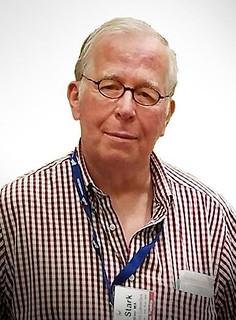
Ask Rex
was a phrase widely used in the Americana collectibles and political ephemera field for many years. Rex Stark died in mid-December while hospitalized in Massachusetts for a multi years-long battle with cancer.
He'd been seen in recent years at major shows experiencing discomfort from medical treatments for cancer, all to little avail. Despite this, Rex was scheduled to attend FUN Orlando early January but fate intervened.
Rex lived for many decades with his wife Patti in Gardner, Massachusetts although they recently bought a second home in Tennessee.
Rex started his dealing / collecting in American smalls
while working for and under the tutelage of Ben Corning who back in the 1970's issued fixed price catalogues. Rex went on to be super-knowledgeable in scrimshaw, American historical porcelain, political memorabilia and really rare American coinage, and widely encouraged and contributed to specialized book references in these fields.
Realizing a dealer cannot collect fields that compete with his clients, Rex built a world class collection of ceramics and related items pertaining to John Brown, the Civil War era abolitionist and insurrectionist hanged by the federal government in 1860 - a person and related events made famous in more than one Hollywood movie, most notably one where Brown was played by noted actor Raymond Massey.
When I first met Rex at a Cherry Hill NJ show in the early 1980's, I was put off by his know-it-all persona and big booming John Ford-like voice. Perhaps this was because he'd once been a Palo Alto, CA police officer, an occupation requiring such a command presence
personality. I know that well.
But I soon got to like him, perhaps because he was so much like me and he did know it all
. He was a fount of knowledge in early American history, rarity, authenticity and value. Rex's prices were always strong
in his 2-3 annual fixed price catalogues but everything, much esoterica, was genuine and usually an opportunity only
purchase. He'd also list several rare early US coins and many rare medals.
He will be missed by many who knew, talked and dealt with him. There is a hole in the heart of many collectors who knew him but many knew this was coming as Rex was not hesitant to discuss his health problems which became increasingly apparent.
"This is one of the last items Rex sold at a major coin show - to me at $4,750. A unique gold fully intact Civil War presentation badge, hand engraved with each battle on the bars approx 6 Ex Ulbrich collection, a major sophisticated collection Rex helped build over decades."
Tony Terranova writes:
"GREAT DEALER!!!!!. Mostly historical ceramics, political everything,, medals, coins,, paper money. Mostly at high to very high, but fair prices. Very knowledgeable on every single item he offered and sold. More importantly, a very dear friend and colleague!!! The numismatic cognoscenti will miss him greatly!!!!!"
Researcher Pete Smith writes:
"He was born on August 30, 1947, the son of civil engineer Donald R.Stark and Dorothy J. Stark."
Rex's wife Patti confirms Pete's added details. Thanks, everyone. I never had the chance to meet Rex, but got his catalogs for years and purchased some items for my collections. He was also a reader and occasional contributor to The E-Sylum. He will be missed. -Editor
BCD CATALOGS ARRIVE IN CHICAGO
Shanna Schmidt published this report in her email Newsletter #211 this week about the arrival of the auction catalog section of Basil Demetriadi's famous library of Greek numismatics. Great news! -Editor
Right now I am working feverishly to empty 490 boxes of catalogs that we just received from Athens, Greece. The long awaited BCD catalogs (not to be confused with the BCD numismatic literature auction that is being sold by Kolbe & Fanning starting in February, 2024) arrived by ship and were finally delivered after a year in the making. While I am excited to have this monumental and important reference library, I also understand the weighty responsibility it carries. The library was cared for and treasured by Basil and his librarian Patricia for several decades. It was also heavily utilized and shared with scholars across the world. I know that its impact on numismatic study was very important and I don't take it lightly.
Along with the overwhelming task of unpacking boxes, we continue our project of digitizing our 6,000 volume library located at 8 S. Michigan. This includes packing books up and driving them either to Internet Archives in Indiana or for the high value books to St. Louis for scanning right at Washington University. Remember to visit the Newman Portal at https://nnp.wustl.edu/ if you want to check out any of the books that are out of copyright and are being offered for public consumption. The ones in copyright will just be available to me on a restricted site for our use.
To read earlier E-Sylum articles, see:
GREEK NUMISMATIC LITERATURE SALE JUNE 2014
(https://www.coinbooks.org/esylum_v17n19a05.html)
MORE ON THE BCD LIBRARY OF GREEK NUMISMATICS
(https://www.coinbooks.org/esylum_v17n20a10.html)
SHANNA SCHMIDT ON NUMISMATIC LIBRARIES
(https://www.coinbooks.org/v23/esylum_v23n08a08.html)
NBS BIBLIOTALK PODCAST WITH SHANNA SCHMIDT
(https://www.coinbooks.org/v24/esylum_v24n19a02.html)
VIDEO: NAC USA NUMISMATIC LIBRARY TOUR
(https://www.coinbooks.org/v26/esylum_v26n33a08.html)
MORE ON THE EVERMAN COUNTERSTAMP
Newman Numismatic Portal Project Coordinator Len Augsburger provided the following report. -Editor
More on the EVERMAN Counterstamp
A Newman Portal user asked about an EVERMAN counterstamp on an 1856 dollar. The counterstamp is listed in the Brunk reference, there on an 1852 Augustus Humbert $50 gold slug.
Eric Schena added to the story in the June 2015 Numismatist, noting other EVERMAN pieces including an 1854 gold dollar, 1854 quarter eagle, and two 1855-O half dollars. Eric's best guess as to the identity of the maker was Louis Everman, a silversmith in Carroll County, TN.
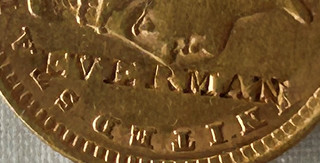 Our correspondent added that the coin was from his uncle, who located the piece while metal detecting in Tennessee. Eric Schena writes
Our correspondent added that the coin was from his uncle, who located the piece while metal detecting in Tennessee. Eric Schena writes What a great find - thank you for sending these images my way; I will add them to my census. I need to revisit that article and see if I can find any additional evidence.
Images: 1856 gold dollar featuring EVERMAN counterstamp, submitted by NNP user.
Link to Newman Portal EVERMAN search results:
https://nnp.wustl.edu/library/searchwithterms?searchterm=EVERMAN
Eric also provided these images of his EVERMAN half dollar and quarter eagle. Thank you! Note that both of Eric's coins are stamped twice, once on the obverse, and once again on the reverse. -Editor
VIDEO: 1715 FLEET SOCIETY 2017 CONFERENCE
The David Lisot Video Library on the Newman Numismatic Portal can be found at:
https://nnp.wustl.edu/library/multimediadetail/522852
We highlight one of his videos each week in The E-Sylum. Here's one from 2017 at the 1715 Fleet Society Conference. -Editor
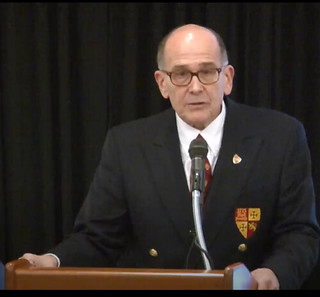 1715 Fleet Society Conference Highlights 2017
1715 Fleet Society Conference Highlights 2017
People talked about why they came to the banquet, comments about 1715 Fleet Conference, banquet remarks, awards to Sergio Gonzales, Curator, Cuban Numismatic Museum, gold coins worth millions discovered on Florida beaches recently, Ernie Richards, editor of Plus Ultra being honored, having membership in 1715 Fleet Society, the youngest girl treasurer and more.
Speakers: Ben Costello. Running time: 40:35.
To watch the complete video, see:
https://nnp.wustl.edu/library/book/540274
MORE ON THE MONEY MUSEUM
Howard R. Engel of Richard Stockley Books ( richardstockleybooks@mymts.net ) addressed these comments to John Regitko, author of the earlier article on the Money Museum of the National Bank of Detroit (linked below). Published here with permission. -Editor
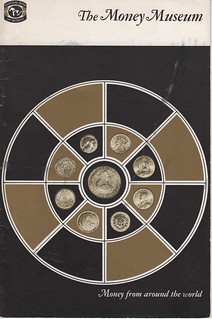 I read with great interest your intriguing article on the "Money Museum of the National Bank of Detroit" in the Nov. 19/23 issue of The E-Sylum, no. 26 no. 47, article 14. Many thanks for sharing it and bringing it to the attention of E-Sylum readers like yours truly. I happen to have a version of the booklet in my stock that is different from the two illustrated in the article.
I read with great interest your intriguing article on the "Money Museum of the National Bank of Detroit" in the Nov. 19/23 issue of The E-Sylum, no. 26 no. 47, article 14. Many thanks for sharing it and bringing it to the attention of E-Sylum readers like yours truly. I happen to have a version of the booklet in my stock that is different from the two illustrated in the article.
National Bank of Detroit. The Money Museum: Money from around the world. Detroit: The Bank, 1966. [12] p. : ill. ; original stapled graphic card covers that show some rubbing and a crease in the top right-hand corner; near fine, $35, plus shipping.
I was dismayed to learn from your article that not only the museum no longer exists, no one seems to know what happened to its significant contents of "over 15,000 specimens of monies from around the world, including the curious, primitive articles of barter used in [the] search for a sound exchange medium" [p. 1] (as of October, 1966, according to the aforementioned booklet).
I find this more than a bit surprising and disconcerting since this money museum consisted of a "vast collection [of] coins, currency, medals and artifacts -- covering a span of 40 centuries. ... the largest collection [that was] on public display in the Midwest. It represent[ed] all countries from ancient Egypt to the United States, all kinds of people from Byzantine rulers to the chiefs of Yap Island, clay tablets from ancient Babylonia, Greek coins from the 7th century B.C., coins of the Ptolemaic rulers of Egypt, coins of Roman and Chinese emperors, coins from medieval Europe and feudal Japan, and current coins of many nations." [p. 2]
I wonder if this means that the only record we have of this impressive money museum are surviving copies of these booklets and numerous articles or references in The Numismatist? Surely, there must be other evidence out there, even if it were reduced to auction lots representing the Museum's ultimate dissolution. At the very least, your article underlines the importance of numismatic literature as part of the historical record that helps to ensure the memory of such bygone collections are preserved for posterity.
It seems to me that the albeit partial story of this particular privately-held museum also serves as a kind of cautionary, if counter-intuitive, tale about well-intentioned plans to preserve significant collections in private, for-profit businesses. I have nothing against private enterprise nor profit, lest I bite the hand that feeds me (my current existence depends on the profit generated from the sale of a family business, to be sure). However, short of government-sponsored collections all-but-guaranteed to be preserved in perpetuity (the Bank of Canada Museum: https://www.bankofcanadamuseum.ca/ comes to my mind as a prime example), the desire to preserve significant private collections in this way may be tantamount to putting all one's eggs in one basket, so to speak. It certainly gives one who may own a significant numismatic collection pause to consider the wisdom and viability of hedging one's bets and rely more on reputable auction houses. They publish catalogues for private collectors to bid on their collections and thereby keep the memory and providence of such collections alive, both through the written/published record of the catalogues, besides the slabbed or otherwise labelled pieces themselves.
As has already been pointed out in a subsequent E-Sylum article, "Shapero, Dodson and their Money Museum" vol. 26 no. 48, Nov. 26/23, article 20. It is noteworthy that The Money Museum of the former National Bank of Detroit was derived from "the notable collection of the Nate S. and Ruth B. Shapero Foundation". [p. 1 of the aforementioned 1966 booklet).
Upon doing a bit of cursory research, the Hans M. F. Schulman auction house in New York sold off some of Nate S. Shapero's gold coin collection (that was not part of The Money Museum) in a Oct. 25, 1971 sale. A significant part of the Museum's collection was purchased from Shapero after the museum opened in 1960 (per Shapero's obit. in the Apr. 1980 issue of The Numismatist, p. 851).
In Nov. 1981, The Abner Kreisberg Corp. offered the award-winning Irving M. Moskovitz collection for the National Bank of Detroit (perhaps for the upkeep of its Money Museum?) according to a full page ad on p. 2226 of the Aug. 1981 issue of The Numismatist. A foreboding development occurred later that decade when the library of The Money Museum was dispersed in 1987, "with several shipments of valuable books donated to the ANA Library", The Numismatist, Aug. 1987, p. 1731.
In terms of what was in The Money Museum's collection, one of the more curious pieces was an 800-pound Yapese limestone cartwheel coin, per the article, "Yap Money in Detroit", The Numismatist, Aug. 1963, p. 1106. A Nov. 1968 Numismatist article (p. 1478-1479) reported that the Museum, for the first time up to that point, put on public display platinum coins from Russia and Germany, "one of the eleven twelve-ruble coins from 1836, a three-ruble piece of the same year and a six-ruble coin of 1830. A platinum medal commemorating Paul Von Hindenburg's first term as President from 1925 to 1932 [was] featured beside a 2-mark pattern piece dated 1926."
Actually, the museum's collection was sold in an auction by Craig Whitford. We hope to discuss this sale further in another issue. But it's quite true that often numismatic literature such as these pamphlets, auction catalogs and periodical articles are the only remaining documentation of such collections after they're dispersed. See the article elsewhere in this issue about the "World's Largest Portable Money Museum".
And don't count on public museums to be good stewards, either. Coin collections donated to such institutions all too often end up pilfered or deaccessioned. -Editor
The Money Museum of the museum officially opened on Apr. 28 1960 and closed in circa 1992. The Numismatist introduced the museum to its readership with a full-page article "Money Museum of National Bank of Detroit" in its June 1960 issue, p. 714. At the time of opening it consisted of 12,500 items. By the fall of 1966 this had grown to over 15,000 items.
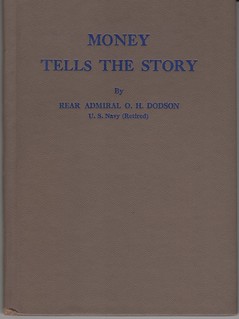 Perhaps the best-known publication of the Museum's first Director (and former ANA President from 1957-1961), Rear Admiral Oscar H. Dodson, U.S. Navy (Retired) is his Money Tells the Story of which I have the following signed copy in my stock:
Perhaps the best-known publication of the Museum's first Director (and former ANA President from 1957-1961), Rear Admiral Oscar H. Dodson, U.S. Navy (Retired) is his Money Tells the Story of which I have the following signed copy in my stock:
Dodson, O.H. Money Tells the Story. Racine, WI: Western Publishing Company, 1962. 64 p. : ill. ; includes bibliography and index; original tan cloth hardcover with blue printing, staples are loosening and the book block beginning to pull away from binding; inscribed on the verso of the title page by the author to its original owner, "To my good friend William Wallace; with kind regards, Oscar Dodson"; subsequent owner's stamp on top right-hand corner of first two leaves; very good-plus; $80, plus shipping.
 I also have a edition of this book from the collection of prominent Canadian numismatist and numismatic researcher and author, Ted Banning (a.k.a. Dr. Edward B. Banning, archaeologist and professor at the University of Toronto known to the numismatic world especially for his ongoing series "The World of Money" about prominent pioneer Canadian numismatists published in Canadian Coin News):
I also have a edition of this book from the collection of prominent Canadian numismatist and numismatic researcher and author, Ted Banning (a.k.a. Dr. Edward B. Banning, archaeologist and professor at the University of Toronto known to the numismatic world especially for his ongoing series "The World of Money" about prominent pioneer Canadian numismatists published in Canadian Coin News):
Dodson, O.H. Money Tells the Story. Racine, WI: Western Publishing Company, 1962. 64 p. : ill. ; includes bibliography and index; original black staple flexcover with gilt printing; "E. Banning" bookplate affixed to the inside front cover; fine; $40, plus shipping.
The Dodson book could be viewed as a handy guide featuring some 25 of the more significant pieces in the Money Museum of the National Bank of Detroit, as the illustrations are of actual specimens in the collection. In his foreword, Dodson writes, "The numismatic material described and illustrated may be viewed in the Money Museum of the National Bank of Detroit. This Museum displays the notable collection of Mr. Nate S. Shapero, Detroit merchant and philanthropist." (p. [5]). To be more specific, these pieces include the following, per the list of illustrations on p. 64:
- Lydia, electrum 1/2 stater of King Alyattes, 610-561 B.C.
- Aegina, silver stater, 600-550 B.C.
- Athens, silver tetradrachm, 450-406 B.C.
- Syracuse, silver victory dekadrachm, after 413 B.C.
- Macedonia, silver tetradrachm of Alexander III, the Great, 336-323 B.C.
- Thrace, silver tetradrachm of Lysimachus, 297-281 B.C.
- Egypt, bronze coin of Cleopatra, 51-30 B.C.
- Roman Empire, silver denarius of Tiberius, 14-37 A.D.
- Moslem Empire, gold dinar of Harum al-Rashid A.H. 180 (796-7 A.D.)
- Florence, gold florin, 1252-1422
- Venice, gold ducat or zecchino of Doga Francis Dona, 1545-1553
- Bohemia, silver Joachimsthaler, "the first dollar", 1518-1525
- Austria, silver taler of Maria Theresa (1780)
- Spanish American Coinage (silver pieces of eight: the cob, eight reales (1734), two reales (1746)
- Massachusetts silver Pine-Tree Shilling (1652)
- North American Indian, wampum belt
- United States, first silver dollar (1794)
- California, private gold issue (Wass, Moliter and Company), fifty-dollar gold piece (1855)
- United States, Saint-Gaudens "double eagle" twenty-dollar gold piece (1907)
- China and Siberia, brick tea money (19th century)
- China, sycee silver ingot (19th century)
- Republic of the Congo, ceremonial axe or "zappozap" that "serves as a symbol of wealth and authority"
- Polynesia, sperm whale tooth necklace (20th century)
- Yap Island, stone money
Finally, for the budget-conscious collector for whom provenance is not a priority, I have this plain copy of the Dodson work:
Dodson, O.H. Money Tells the Story. Racine, WI: Western Publishing Company, 1962. 64 p. : ill. ; includes bibliography and index; original tan cloth hardcover with blue printing, the book block is all but pulled away from binding; good; $20, plus shipping.
Howard adds:
"Yes, thanks for pointing out the sale of the National Bank of Detroit's Money Museum through Craig Whitford. I discovered from Bryce Brown's fixed price list that it was in (at least) three separate sales on June 12-13, 1992, Nov. 30, 1992 and Apr. 30, 1993.
"The first sale of 1499 lots in 67 pages included "ancient and world coinage; Bryan money, encased postage, currency, and medals, including a couple of Libertas Americana". Part 2 consisted of 1088 lots in 26 pages and featured "Camelot, Mediterranean and Salzburg" (a rather cryptic description from Brown, are these coins, tokens, medals and/or paper money?) The third sale of 1701 lots in 71 pages included "ancients through world and US; Atocha & Nicobar salvage, early U.S. copper and bust coinage".
"Judging from the total number of lots through all 3 sales which is 4288 lots, there must have been some bulk lots to round out to the 15,000-plus specimens in the collection. This is assuming, of course, that the Money Museum's collection was completely sold off in these three sales. According to Brown, these particular Craig Whitford auction sales are scarce (to say the least) and he has them priced accordingly. So it looks like the mystery of what happened to the National Bank of Detroit's Money Museum is more or less solved!"
John adds:
"I bought three dozen of the black-cover "Money Tells The Story" many years ago for $1 each, along with the Whitman booklets on Paper Money and Coins. Rather than reselling them all, I should have read it first so I didn't miss the fact that Dobson was behind the Money Museum, possibly when I visited it so many decades ago.
"I wonder how many collectors have books in their library that they never read? I bet every one!"
While I've devoured many new additions to my library, they're not all page-turners. Lots of books were purchased for future reference. While many future references were indeed made, I must admit that I never read a lot of them cover-to-cover. Life just gets in the way. I greatly admire friends like Dave Hirt who has read, retained, and retold many interesting numismatic facts that I should have known, but didn't. -Editor
To read the earlier E-Sylum articles, see:
MONEY MUSEUM OF THE NATIONAL BANK OF DETROIT
(https://www.coinbooks.org/v26/esylum_v26n47a14.html)
SHAPERO, DODSON AND THEIR MONEY MUSEUM
(https://www.coinbooks.org/v26/esylum_v26n48a20.html)
MONEY MUSEUMS IN THE U.S., PART ONE
(https://www.coinbooks.org/v26/esylum_v26n49a16.html)
AI-GENERATED COIN BOOK COVERS
Last week Ron Guth announced that he'd written A Practical Guide To Becoming A Coin Dealer with help from a robot friend. There was no cover illustration yet, so I invited our readers to submit candidates, with or without the help of AI tools. First up is author Gary Beals. -Editor
OK robot – here is your book cover —
Well, what the hell, humans failed me for the most part — In 2015 I put 1,950 hours into my numismatic dictionary plus $8,000 or so in production and printing of 1,000 copies of the 352-page book. I wonder how many hours the robot would have needed?
I am happy with my book in spite of the low interest collectors seemed to have in learning more. So if I was to donate a cover idea for a coin dealers book, it would be just like the cover of my actual book, Numiscadero.
Mr. Robot would simply direct the cover artwork to drop off the text layer and it would run with the numismatic items and its own cover information
The difference – I will let that robot use the experimental blue background version rather than the actual printed one in red. The coins, medals, banknote and ingot face plate are from my collection at the time. I arranged them and a professional photographer took the shot.
Gary has returned to the U.S. since publishing the book. Copies can be ordered from him at segovia.gary@yahoo.com . -Editor
For more information on Gary's book, see:
NEW BOOK: EL NUMISCADERO
(https://www.coinbooks.org/v20/esylum_v20n03a02.html)
BOOK REVIEW: EL NUMISCADERO
(https://www.coinbooks.org/v20/esylum_v20n20a05.html)
Ron Guth writes:
"I played around with ChatGPT and came up with the two attached covers. It seems that Dall-E (the image generator in ChatGPT) will come up with a new and different cover over and over again even if you insert the same prompt. The AI will also start throwing some anomalies in there, such as misspellings, missing words, etc.). Even so, the tech is very quick, innovative, and fun to play with."
Interesting how it picked up the magnifying glass motif! Not bad first efforts. I tried creating an image with DALL-E using Microsoft's Bing and it produced a nice image of "A Practical Guide to Everything." No coins! But it helpfully offered to add a coin image, and this time the results were more reasonable. Still weird, but plausible starting ideas. -Editor
To read the earlier E-Sylum article, see:
NEW BOOK: GUIDE TO BECOMING A COIN DEALER
(https://www.coinbooks.org/v26/esylum_v26n51a06.html)
UPDATE: AI-POWERED APP NUMI
Justin Hinh submitted this update on his AI-powered coin grading and identification app. Thank you! -Editor
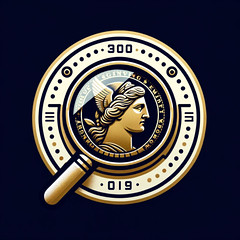 I wanted to share an update on Numi with you and E-Sylum readers.
I wanted to share an update on Numi with you and E-Sylum readers.
I revamped my AI grading and identification app Numi to v1.33 to use the official American Numismatic Association's grading standards. My goal was to transform Numi to focus solely on technical grading, as technical grading is much more objective as compared to market grading.
Attached are some results for coins ranging from G-4 to PR-70.
As you can see, the results were quite off. With Numi getting increasingly accurate as the coin moved to a better condition.
Numi struggles quite a bit with recognizing wear on a coin. Interestingly enough, this was the exact issue Compugrade experienced back in the 90's. Even though their algorithms were completely different than today's AI Large Language Models.
Given Numi's failure to achieve consistent results, I am putting the project on ice until the next OpenAI GPT model is released. I'm also interested in testing Numi using Google's Gemini Ultra model once that releases sometime next year. Once they do, I will revisit these tests and see how much Numi has improved.
Observations & Lessons Learned
- Like what many online are reporting, GPT-4 has substantially degraded in performance in the past few months. I found myself constantly arguing with the AI to get it to follow most of my custom instructions.
- The model can follow custom instructions well for the first 8-10k tokens, but perception and logic fall off a cliff after that. Even with highly tailored instructions with clear steps to follow, Numi would veer off course when it had to process too much info. This was incredibly frustrating as GPT-4 Turbo claimed to have a token limit of 128k [i.e. ability to remember up to nearly 25k words].
- The vision model needs a major boost. The Optical Character Reader was great at picking up texts on coins. I rarely had it misread the text. But often it would fail to pick up the mint mark on more worn coins. The vision model could generally tell when a coin was more worn, but it failed to apply a correct grade.
- Numi was excellent at identifying non-ancient coins. And was quite often great at identifying tokens. But it struggled immensely with Ancient coins. The only ancient coins it could identify were coins in very high condition.
Overall Numi was a fun and exciting project. I got to apply my AI knowledge to my hobby and I'm excited to see how future models perform. AI is a force to be reckoned with and it's going to be an invaluable resource for researchers and those trying to learn more about their coins. I left this project feeling that AI technical grading would eventually work. But I now have my doubts that it can overtake market grading in a manner that would be widely adopted.
Thank you for the thorough evaluation report. I, too, remain optimistic for AI's future contributions to numismatics. We usually stay out of grading and pricing discussions at The E-Sylum, but appreciate the progress shown here with identifying tokens and non-ancient coins. I think text-rich paper money will also lend itself well to machine identification. Machines will continue to augment and improve human efforts, but many (if not most) tasks will remain best performed by humans. -Editor
To read the earlier E-Sylum articles, see:
NUMI: AI-POWERED COIN IDENTIFICATION APP
(https://www.coinbooks.org/v26/esylum_v26n47a10.html)
NUMI: HOW THE AI SAUSAGE IS MADE
(https://www.coinbooks.org/v26/esylum_v26n47a11.html)
To read about the Brazilian Councilman writing laws with ChatGPT, see:
The City That's Trying to Replace Politicians With Computers (It's Working)
(https://www.wsj.com/tech/politican-ramiro-rosario-artificial-intelligence-brazil-82ca338d)
NOTES FROM E-SYLUM READERS: DECEMBER 24, 2023
National Amateur Painters Competition Medal
Scott Miller writes:
"Regarding your notice about David Smith and his Medals for Dishonor, I thought you might be interested in this other medal by him. In 1949, David Smith was commissioned by Art News to create a prize medal for the National Amateur Painters Competition. He signed the 70mm medal on the reverse with the Greek letters ? S. The example here was awarded to Gayle Ward for the 1954-1955 competition."
Thank you - nice medal. -Editor
Judy Blackman edits the Nashua Numismatist for the Nashua Coin Club. She writes:
"This is so funny Wayne. I just put the Medals of Dishonor (14 of the 15) in an article in the NCC newsletter (Jan. issue) as there is already a 2-page article and asked the other members of the team to not submit anything on him for our 20th century artistic medals topic, and then today I open my E-Sylum and there's two articles pertaining to David and his medals. I was missing the book in our article, so I'm going to add that. Just letting you know Wayne, as I didn't want you to think I stole your idea and content. David was a remarkable artist to document some very serious times in our world history. As always Wayne, thanks so much for all that you do!"
Great minds think alike! Actually, I don't think I'd ever heard of David Smith until I saw the Harvard press release. He did great work! -Editor
For more on Smith's life and work, see:
More than a Man, Less than a Painter: David Smith in the Popular Press, 1938–1966
(https://www.mdpi.com/2076-0752/12/4/153)
To read the earlier E-Sylum articles, see:
DAVID SMITH'S MEDALS FOR DISHONOR
(https://www.coinbooks.org/v26/esylum_v26n51a26.html)
MORE ON MEDALS FOR DISHONOR
(https://www.coinbooks.org/v26/esylum_v26n51a27.html)
Michael Kirzner Information Sought
Mike Bourne writes:
"I read with interest the article by Pete Smith. As part of my research for my 3c pattern book, I have been trying to elicit more information regarding Michael Kirzner. In 1974-1975, he published a number of Fixed price lists out of Boston under the name American Gold Exchange. These Fixed price lists in the Summer 1974 had a significant number of patterns, many of them unique. It was one of the most significant listing of patterns ever in a series of fixed price lists.
"My particular interest has been J-804 which was first ever listed for sale by Elder 4/11/1935 of the Adams/Parker Collection , then was noted in the Farouk Palace collection of Sotheby in 1954. It then shows up in the American Gold exchange FPL in 7/17/1974. It has not been sold or certified since that time. Romano had 50 patterns in his Stacks sale.
"The question begs, how does a recently convicted, seemingly obscure dealer come into the possession of such a collection? If anyone has further information regarding Michael Kirzner, I would appreciate to hear back."
I located a PCGS CoinFacts image of the J-804A pattern, but Mike set me straight - see his followup comments below. -Editor
Mike adds:
"J-804 has never been photographed. Interestingly, the J-804 was listed in the American Gold Exchange 7/17/74 price list as its only listing. This is at the same time the 5th edition Judd book comes out in 1974 listing J-804A for the first time. The J-804 is never listed again in these FPLs but the J-804A is now listed in the American Gold Exchange price lists 9/11/1974, 10/16/1974, 2/26/1975, and 3/26/1975 at the same price as the J-804. So either the J-804 was immediately sold or it was re-characterized as J-804A.
A very large number of these patterns from the American Gold exchange find themselves being sold in the Bowers/Ruddy Winthrop collection of 9/19/1975, which I suspect this one pictured was. However, I can not prove this definitely as Bowers/Merena listed a J-804A in a fixed price list on 7/18/1990 - this has also never been photographed or certified. The Winthrop collection had 141 patterns listed for sale."
Interesting research conundrum, and a perfect example of the utility of collecting numismatic literature. Can anyone help? -Editor
To read the PCGS CoinFacts article, see:
1870 3C J-804a (Proof)
(https://www.pcgs.com/coinfacts/coin/1870-3c-j-804a/61048)
To read the earlier E-Sylum article, see:
THE BOSTON STAMP HEISTS
(https://www.coinbooks.org/v26/esylum_v26n51a16.html)
World Banknote Auctions is hiring!
Are you interested in something new in the New Year?
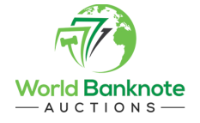 World Banknote Auctions (WBNA) is looking for a U.S. based person interested and experienced with U.S. and/or World Paper Money to serve as marketing contractor to support our social media and print advertising program. This is a remote contract position; occasional travel to the head office in Sacramento, CA may be required. Hours are flexible; compensation is based on experience and hours worked.
World Banknote Auctions (WBNA) is looking for a U.S. based person interested and experienced with U.S. and/or World Paper Money to serve as marketing contractor to support our social media and print advertising program. This is a remote contract position; occasional travel to the head office in Sacramento, CA may be required. Hours are flexible; compensation is based on experience and hours worked.
Intermediate knowledge of Photoshop, InDesign, Adobe Premiere Pro, Microsoft Office 365 is required. Knowledge of SEO, Google Ads, and Analytics is not required but is a plus.
Interested collectors should email ryan@worldbanknoteauctions.com with a resume and past marketing samples.
Air Conditioning Pioneer Stuart Cramer
Bern Nagengast writes:
 "In The E-Sylum Dec. 17 one of the photos taken by Greg Adams at the Charlotte Mint shows a display panel
"In The E-Sylum Dec. 17 one of the photos taken by Greg Adams at the Charlotte Mint shows a display panel The Mint as U S Assay Office
that featured superintendent and chief assayer Stuart Cramer. The panel doesn't mention it but Cramer was an expert in indoor climate control for cotton mills and was the first to use the term Air Conditioning
in a US patent he filed in 1906.
Three years later Cramer commented: When entering this field, several years ago, I was puzzled to find a word that would embrace this whole subject. In casting about, I finally hit upon the compound word, ‘Air Conditioning' which seems to have been a happy enough choice to have been generally adopted. The idea was suggested by the use of the term ‘Conditioning' in the treatment of yarn and cloth, and even of raw materials before manufacture.
"
"Cool" fact! Thanks. -Editor
To read the earlier E-Sylum article, see:
CHARLOTTE MINT MUSEUM COIN EXHIBIT
(https://www.coinbooks.org/v26/esylum_v26n51a11.html)
Coin Weight as Proprietary Information
Eric Hodge writes:
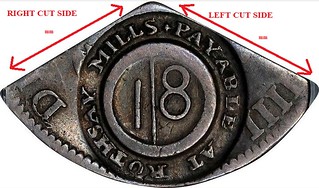 I have often read, in your columns, the pros and cons of encapsulated coins. I have recently become aware of what I consider a major failing of this system. My numismatic interests are the series of UK merchant countermarked dollars. Some examples are due for sale in a Stack's Bowers auction on 13th January 2024, session E, lots 53299 to 53306. The lot that particularly interested me was 53299, a Rothsay Mills cut third for 1s 8d.
I have often read, in your columns, the pros and cons of encapsulated coins. I have recently become aware of what I consider a major failing of this system. My numismatic interests are the series of UK merchant countermarked dollars. Some examples are due for sale in a Stack's Bowers auction on 13th January 2024, session E, lots 53299 to 53306. The lot that particularly interested me was 53299, a Rothsay Mills cut third for 1s 8d.
On 30th March 2019 I wrote an article for the British Numismatic Society Blog entitled ‘Analysis of Cut 8 Reales Countermarked by Rothsay Mills'. It can be seen from this article the importance of the coin's weight for my research. When I contacted Stack's Bowers for the weight of lot 53299 their answer was ‘Unfortunately there is no way to get an exact weight as the coin is encapsulated.' Unperturbed, I contacted NGC (the encapsulator) to be told 'We do not record the weight of coins on the label or internally, but when coins come in for grading and encapsulation they go through many verification procedures to confirm that the coin is authentic. If the coin is authenticated we would proceed with grading and encapsulation of that coin. We wouldn't grade it if we were uncertain of the authenticity of it. Regarding the weight of the slabs by themselves, we are not able to provide that information as it is proprietary information.'
Truthfully I could not believe what I was reading. Surely one of the standard forms for authenticating a coin is its weight? Without that it is difficult to be sure of the metal content and for medieval coins and earlier it is the weight that can confirm denomination. It now appears that if a coin is encapsulated then its weight is lost. That seems to me to be very poor management. I am assuming all the various firms doing encapsulation operate the same way. I would be very pleased to hear comments from your readers either confirming what I have written, or giving an alternative view. Does any reader know what the weight of an NGC capsule plus coin surround would weigh in grams? (Why should this be 'proprietary information'?)
Interesting topic. It would make perfect sense to me that the grading companies would measure, weigh and photograph every coin, and publish the information somewhere even if it doesn't all fit on the slab label. Given that weight is an important factor in determining authenticity, perhaps they hold that information back to avoid giving counterfeiters too much information. Can anyone shed light on this practice? -Editor
Dollar Bill Design Idea
Wayne Pearson submitted this dollar bill design idea. Thanks. -Editor
Pooping Pooch Counterstamp
Here's one I came across myself on Facebook. I've misplaced the link, so I can't give credit for this, but thanks. Definitely an unusual counterstamp, but not an unusual sight, especially for someone like me whose window overlooks a neighborhood sidewalk frequented by dog walkers. -Editor
ACQUIRING A 1788 R 4-G MASSACHUSETTS CENT
Jeff Burke submitted this article about his recent acquisition of a nice 1788 Massachusetts Cent. Thank you! -Editor
Jeff Burke
From childhood, I learned about my family roots in colonial New England. Our Brewster
genealogical records, on my mother's side of the family, trace our family ancestry back to the
Mayflower, with many generations residing in Massachusetts. We are the direct descendants (14th
generation!) of Elder William Brewster, a passenger on the Mayflower (for more information on
him, see the entry on Brewster-William,
mayflowerhistory.com).
Coincidentally, Beth, my wife, and I had the chance to explore Massachusetts a bit when I was a visiting professor at College of the Holy Cross in 2007 to 2008. I recall finding and checking out many numismatic books at the Worcester Public Library and attending local coin shows. I drove into Boston to attend the Bay State Show at the Radisson Hotel in 2008. It was my first time attending such a major coin show!
I thought about my dad when I began studying Massachusetts colonial half cents and cents with
an American Indian depicted on the obverse. Julius, my late father, was fascinated by Native
American history, artwork and spirituality. He would have been intrigued by the design of these
coins. Q. David Bowers notes that the Massachusetts cents and half cents represented the first
time CENT appeared on a coin made in the United States. He also explains that Among all
copper coins issued by the different states during the 1780s, the Massachusetts pieces were the
best struck and of the most uniform weight.
(Bowers, Whitman Encyclopedia of Colonial and
American Coins, p. 197). Craig Sholley and John Dannreuther add, Massachusetts coppers
…are the first coins struck at a government-owned and operated mint, the first with
denominations as part of the design, the first with legends in English, the first with an American
Indian motif, and the first with a federal-style heraldic eagle with shield, arrows, and olive
branch on the reverse[.]
(Sholley and Dannreuther, The First U.S. Coins were…the State
Coppers,
in Penny-Wise, vol. LVII, no. 3, July 2023, p. 107).
Michael Brooks, a member of the New Jersey Numismatic Society, brought a beautiful 1787 MA Half Cent Ryder 4-C NGC EF 40 for show-and-tell at our NJNS meeting in January 2023. Mike had just purchased this coin at the FUN Show. I studied it with my magnifying glass and considered the possibility of buying a specimen for myself.
To further educate myself, before I started looking into specimens for sale, I conducted research on the Newman Numismatic Portal, examined Stack's Bowers and Heritage online auction records, and studied PCGS CoinFacts. I also reread sections pertaining to Massachusetts coppers in the Whitman Encyclopedia of Colonial and Early American Coins, by Q. David Bowers.
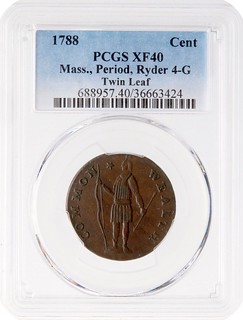 Next, I examined numerous Massachusetts coppers on various dealer websites, ranging in grade
from About Good to Mint State. Then, I discovered a 1788 R 4-G MA Colonial Cent PCGS XF
40 listed on Chris McCawley's Early Cents website (earlycents.com). After exchanging texts and
having phone conversations with Lucas Baldridge at Early Cents, we worked out a deal. I am so
thrilled to own this coin! Lucas was gracious, friendly and a pleasure to work with.
Next, I examined numerous Massachusetts coppers on various dealer websites, ranging in grade
from About Good to Mint State. Then, I discovered a 1788 R 4-G MA Colonial Cent PCGS XF
40 listed on Chris McCawley's Early Cents website (earlycents.com). After exchanging texts and
having phone conversations with Lucas Baldridge at Early Cents, we worked out a deal. I am so
thrilled to own this coin! Lucas was gracious, friendly and a pleasure to work with.
My coin is described as being choice glossy medium chocolate brown with areas of lighter
brown toning on both sides. The planchet quality is extraordinary. It is a remarkable example of
a variety that was missing from the Partrick Collection. I felt drawn to the provenance,
summarized on the Early Cents website as Ex; Thomas L. Elder 10/17/1908:46 – Hillyer Ryder-
F.C.C. Boyd – John J. Ford, Jr., Stacks's 10/2004:125 – Jack Wadlington (The Twin Leaf
Collection), Stack's Bowers 3/1/2019:8033 – George Trostel Collection.
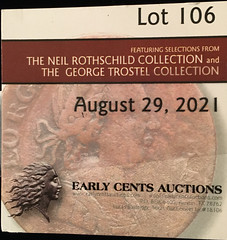 I was thrilled when my Massachusetts colonial coin arrived in mid-December. What a
magnificent specimen! My coin came with a small card containing the following information:
I was thrilled when my Massachusetts colonial coin arrived in mid-December. What a
magnificent specimen! My coin came with a small card containing the following information:
Featuring Selections from the Neil Rothschild Collection and the George Trostel Collection,
Lot 106, Early Cents Auctions, August 29, 2021.
I am now checking old auction records to learn more about the provenance of my piece. Ray Williams told me that Mike Packard is working on a book about Massachusetts colonial coppers. I can't wait to read it!
Note: Lucas Baldridge of Early Cents kindly gave me permission to use the obverse and reverse images of my coin from the Early Cents website to accompany this article.
Nice coin! Every collector should be as methodical as Jeff in researching their purchases - this is why numismatic literature exists! -Editor
DICKENS LAND LONDON 1941 MEDALS
Back in 2012 Philip Mernick asked about two bronze medals depicting Dickensian characters with the inscription FROM DICKENS LAND LONDON 1941. He wrote, "1941 London was not the time or place for exhibitions or medal making. Could they be American?" I don't believe we've gotten an answer about their origin. -Editor
A website visitor writes:
"My name is Ejner Thomsen from Copenhagen. I am writing in connection with a house conversion in London where I found these medals. Looked on Google for answers for these and found them mentioned by you in 2012. Can't contribute more news than sending photos of the 6 different ones I have."
Thank you! I guess this is another clue, but we still have no answer. Wikipedia tells me there was a "Dickens World" theme park in Kent, England from 2007 to 2016. There was also a Dickens fair, Dickens Christmas fair and Dickens Fete or Dickens festival. The name/phrase "Dickins Land" is associated with three books and the places in and around Kent where Dickins lived for many years.
Another clue comes from this Worthpoint entry. -Editor
King Henry Books Set of six Dickens Character Medals Each have the inscription :- From Dickens Land 1941 Looks like they are cast in bronze or brass. Measure 2 1/2 in. across & are 1/3rd of a pound in weight (150g) each They all have a hole drilled in the back for hanging purposes. Dickens himself! Betsy Trotwood Mr. Pickwick Behold the Moral Pecksniff Mrs. Gamp Bill Sikes.
To read the complete Worthpoint entry, see:
CHARLES DICKENS— 6 DICKENS LAND CHARACTER BRONZE PLACQUES 1941 SET OF SIX MEDALS
(https://www.worthpoint.com/worthopedia/charles-dickens-dickens-land-305118669)
So "King Henry Books" is another clue, but I'm coming up empty. Can anyone take this to the next level? Perhaps there is a newspaper or magazine ad describing these medals in conjunction with the publication of a book or set of books. -Editor
Philip Mernick writes:
"I have been round and round in circles over the years getting nowhere so good luck!"
To read the Wikipedia articles, see:
https://en.wikipedia.org/wiki/Dickens_World
https://en.wikipedia.org/wiki/Dickens_fair
To read the earlier E-Sylum article, see:
QUERY: DICKENS LAND LONDON 1941 MEDALS
(https://www.coinbooks.org/esylum_v15n50a10.html)
VOCABULARY TERM: OVERSIZE FLAN
Here's a short entry from Dick Johnson's Encyclopedia of Coin and Medal Terminology. I was unable to locate an image of the medal mentioned. Are there examples of coins struck this way? Can anyone help? Thanks. -Editor
Oversize Flan. A blank larger than intended for a particular coin or medal. Oversize flans will clog or otherwise mis-strike in a coining press (because of collar dies). Open face dies can easily strike oversize flans and are occasionally used to create medals larger than dies employed. A recent example, the Haile Selassie Medal for the New York Rotary Club, 1 1/2-inch, was struck from two 1 1/4-inch dies; the resulting 1/8-inch border was inscribed with lettering. The wide border on such pieces has a tendency to bow up as the center is struck and becomes depressed. Oversize blanks are always used in proving newly cut dies, and often used in die trials.
To read the complete entry on the Newman Numismatic Portal, see:
Oversize Flan
(https://nnp.wustl.edu/library/dictionarydetail/516446)
FREDERICK WILLIAM HARRIS (1872-1938)
E-Sylum Feature Writer and American Numismatic Biographies author Pete Smith submitted this article on Rev. Fred Harris and the Harris portable money museum. Thanks! -Editor
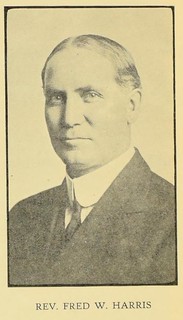 Fred W. Harris came to my attention while compiling a list of money museums in the United
States. I was not familiar with his extensive collection and its museum.
Fred W. Harris came to my attention while compiling a list of money museums in the United
States. I was not familiar with his extensive collection and its museum.
This story should begin with his birth on May 23, 1872. There is a record for his Christening at Fenny Compton, England, on June 30, 1872. The 1880 Census shows his family living in Bloomington, Wisconsin, with older siblings born in England and younger sisters born in Wisconsin. This would indicate the family moved to America in late 1872 or early 1873. Perhaps as a good Christian, he was born again because the 1920 and 1930 Census gives his place of birth as Wisconsin. His obituary gives his place of birth as Bagley, Wisconsin. He retained the same parents, John Henry Harris (1843-1909) and Sarah Rachel Print Harris (1843-1922).
On August 14, 1889, Fred Harris caught a fourteen-pound blue catfish south of Prairie du Chien. The next morning, he took it into town and sold it to James Harvey for fifteen cents paid with a piece of fifteen cents currency. He saved that piece and built a museum around it.
He graduated from Epworth Seminary in Epworth, Iowa, in 1898. He went on to receive a B.A. degree from Lawrence college in Appleton, Wisconsin in 1902, an S. T. B. degree from Boston University School of Theology and his M.A. and Ph.D. from Illinois Wesleyan.
Harris married Estelle Maude Barrett Harris (1877-1955) on June 24, 1903. They were the parents of Lawrence Barrett Harris (1905-1962), Dorothy E. Harris (1908-1979), Wilfred J. Harris (1910-1998) and Robert Russell Harris (1915-1993).
Harris served as a Methodist pastor in Chippewa Falls from 1909 to 1917. From there he went to Platteville. In 1925 he was appointed district superintendent for the Madison-Platteville area. He retired from the ministry in 1937.
Harris joined the A.N.A. on February 1, 1926, as member 2963. He attended the ANA conventions in 1929 and 1936.
In 1932, he joined Gordon Gill to form the Madison Coin Club in Wisconsin. Reports of club meetings often mention fewer than ten people in attendance.
In 1936, Harris served on the committee that proposed and promoted the Wisconsin
commemorative half dollar. He was designated as Director of Distribution
for the Wisconsin
Territorial Centennial Half Dollar. Issue price was $1.50. He placed a half page ad in The
Numismatist for July 1936. Many orders were taken before the coin was struck and available for
distribution.
On April 26, 1937, Harris exhibited a 1792 Martha Washington half disme at the Madison Coin Club. I did not find this in the Bolender sale of his collection.
He assembled a library of more than 1600 volumes. He collected books on theology, history and numismatics.
Harris used his connections to write to Methodist missionaries around the world seeking examples of primitive money. He had an example of every piece of money mentioned in the Bible.
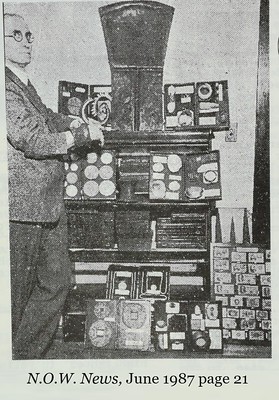 He prepared four separate exhibits beginning with
He prepared four separate exhibits beginning with Centuries of Progress
with coins dated from
5000 B.C. to the present time. His Around the World Series
showed countries listed
alphabetically. His American Indian Series
included barter items from the native tribes, The
fourth exhibit was his Odd Curious and Novel Series
with several hundred pieces.
The museum included many small frames that could be shown with smaller or larger exhibits. The format would be different at different locations. As it was described, the entire museum could fill six rooms of a house.
The Harris portable money museum operated in the shadow of the popular Chase Bank Money Museum in Manhattan. The Harris collection was described as more extensive than the Chase Museum. The Chase Museum ended up at the Smithsonian. The Harris collection was broken up and sold at auction.
During the summer of 1938, his travelling museum settled in Wisconsin Dells opposite the Riverview Boat Landing. With more than 35,000 coins, it was described as the world's largest portable money museum.
His claim that the collection covered money back to 10,000 B.C. is a bit of a stretch. He included cuneiform clay tablets he described as predecessors to paper money.
Harris died in Madison, Wisconsin, on November 28, 1938. He is buried with his wife at Roselawn Memorial Park in Monona, Wisconsin. For his funeral, six methodist ministers from Madison carried his casket to the grave. In December, the value of his estate was given as $8,500.
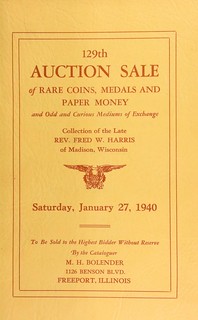 His collection was offered at auction in M. H. Bolender's 129th Auction Sale on January 27.
1940. Bolender said the collection weighed a ton. The sale had 1792 lots, a nice numismatic
number. Many lots sold for less than a dollar and few more than $15.
His collection was offered at auction in M. H. Bolender's 129th Auction Sale on January 27.
1940. Bolender said the collection weighed a ton. The sale had 1792 lots, a nice numismatic
number. Many lots sold for less than a dollar and few more than $15.
Many lots were exhibit cases with multiple items sold as one lot. Lot 272 included 123 Chinese cash coins listed as realizing one-fourth cent. I assume that was per unit and not for the whole lot. In general, coins were circulated rather than preserved in high quality.
A 30-pound Yap stone (lot 572) brought $31. Another yap stone (lot 573) at 44 pounds brought $35. I searched for the Indian copper piece shown in one photograph. I suspect that was lot 617 described as Eskimo Thousand Blanket Money, 17 x 30 inches bringing $35. Like Breen's Guinea pig, in my opinion these are not Eskimo and not used as money. That would require a long explanation.
I wasn't aware of this "portable money museum" either. Many thanks to Pete for surfacing this and making us all aware of its existence. Important hobby history! Among the odd and curious items are Frog Money (lot 433), Russian Cheese Money (lot 462) and Sole Leather Money (lot 527). The sale also included a great collection of Bryan money (lots 767-856).
Do any of our readers have numismatic items or numismatic books traceable back to Fred Harris? -Editor
To read the Bolender catalog on the Newman Numismatic Portal, see:
129th auction sale of rare coins, medals, and paper money and odd and curious mediums of exchange. [01/27/1940]
(https://nnp.wustl.edu/library/auctionlots?AucCoId=18&AuctionId=514761)
WBNA WORLD CURRENCY SALE 53
Consignment Director Ryan Baum of World Banknote Auctions sent along these highlights and comments on their upcoming World Currency Sale 53. Thanks. Great notes! -Editor
I always am interested in the oldest banknotes by country or continent. In our current sale we feature one of the oldest on a global basis from over six hundred years ago. The image appears dark and the oversized holder cloudy because of the fiber of the note.
Only the third example of what is considered one of the earliest collectible banknotes we have handled. While the printing of banknotes in China had been fairly well established at this point (Marco Polo was familiar with earlier issues), surviving notes dating prior to 1368 are extremely rare and can be considered non-collectible for all intents and purposes. The Ming dynasty notes are more available, thanks to a few groups that were found in the early 20th century. Most are seen in various states of conservation, but all examples are very collectible, and examples of this historic banknote are always in demand. This example retains strong eye-appeal, and the stains mentioned PMG are not distracting and very minimal and in our opinion should probably not even be mentioned. PMG mentions "Stains".
To read the complete lot description, see:
China / Ming Dynasty ND (1368-99) P-AA10 PMG Very Fine 30 1 Kuan
(https://bid.worldbanknoteauctions.com/lots/view/4-C7WAZC/china-ming-dynasty-nd-1368-99-p-aa10-pmg-very-fine-30-1-kuan)
High denomination notes are also of interest as many were not intended to circulate in daily commerce but reserved for inter-bank or farmer payments. This high denomination Scottish note had only 1,000 in the print run for this small bank issuer. If this were a coin, its value would be in the mid five figures.
With a print run of just 1,000 notes, this high denomination from the Union Bank of Scotland is a rarity among the banknotes of Scotland. Not only was 100 Pounds a considerable amount of money shortly after World War II, the small print run meant that few people of the general public would ever see this denomination in commerce. It was reserved for larger transactions, and as a result, this denomination was printed infrequently at best.
Printed on handmade paper, this is a classic issue from this banking institution, which had opened its doors back in 1843 as the continuation of the Glasgow Union Banking Company. Less than a decade after this note was issued, in 1955, the company (at the time the second smallest banking institution in Scotland) was acquired by the Bank of Scotland and ceased to exist as an independent institution.
To read the complete lot description, see:
Scotland, Union Bank of Scotland Ltd. 18.2.1947 P-S814c PMG Choice Extremely Fine 45 EPQ 100 Pounds
(https://bid.worldbanknoteauctions.com/lots/view/4-C7WBCM/scotland-union-bank-of-scotland-ltd-1821947-p-s814c-pmg-choice-extremely-fine-45-epq-100-pounds)
This month we also have a special session dedicated to Persian notes. Over the past 18 months Persian notes have become incredibly popular and the volume of notes at auction have increased along with their values.
For advanced Persian collectors who aim to collect the Toman notes across payable locations, many of the locations outside of Tehran are very hard to find, especially in issued form. We have a 20 Toman note payable on Meshed, a location that appears on the market very infrequently.
Payable at Meshed. An iconic denomination and type that is very rarely available in issued form. This is the first time we have been able to offer an issued note of this type and denomination, and a survey of publicly available auction records show precious few offerings of this type anywhere over the past decade. While some repairs are seen, they have certainly enhanced the appearance of this type, and the overall eye-appeal is excellent. This example is payable at Meshed, and dates to 1924. PCGS mentions "Multiple repairs, design redrawn".
To read the complete lot description, see:
Persia 11.12.1924 P-15 PCGS Choice Fine 15 DETAILS 20 Tomans
(https://bid.worldbanknoteauctions.com/lots/view/4-C7W77U/persia-11121924-p-15-pcgs-choice-fine-15-details-20-tomans)
We have another issued note payable on a regional city, this one payable on Tabriz.
Payable at Tabriz. From the second series of the Imperial Bank of Persia and a piece that has the appearance of a nicer grade than the PCGS holder suggest. Strong color is seen, and the piece presents better than the majority of this type out there. Tabriz is a city in Northwestern Iran. PCGS mentions "Repairs"
To read the complete lot description, see:
Persia 1.9.1925 P-11 PCGS Very Fine 25 DETAILS 1 Toman
(https://bid.worldbanknoteauctions.com/lots/view/4-C7W77O/persia-191925-p-11-pcgs-very-fine-25-details-1-toman)
The Persian Session also has several interesting specimens. For the color and portrait of Reza Shah Pahlavi, I like a seldom seen Thomas De La Rue specimen of a 10,000 Rials from 1938.
Only the third example of this scarce specimen that we have been able to handle. Light (mis)handling is seen, but the note is otherwise fully original with excellent eye-appeal.
To read the complete lot description, see:
Iran ND (1938) / AH1317 P-38Cs PMG About UNC 55 EPQ 10,000 Rials (Specimen)
(https://bid.worldbanknoteauctions.com/lots/view/4-C7W79O/iran-nd-1938-ah1317-p-38cs-pmg-about-unc-55-epq-10-000-rials-specimen)
FRANK S. ROBINSON 123ND AUCTION
Here's the announcement for dealer Frank S. Robinson's January 23, 2024 sale. -Editor
Dealer Frank S. Robinson will conduct his 123rd mail and internet auction of Ancient and Early Coins with a closing date of January 23. The sale will include 577 lots, low minimum bids, and bids to be reduced as competition permits. Robinson notes that reductions have averaged 15-20% in his recent sales. There is no buyer fee.
Featured in this sale is a further segment of a major collection of Judaean and Judaic related material, including some rare and important items. Highlights include a Judaea aureus of Vespasian, and an extremely rare Caracalla Tetradrachm of Aelia Capitolina (Jerusalem).
Greek coins include a slabbed AU Armenian Trigranes II
Tetradrachm; several classic Athenian Owl
tetradrachms in choice quality; an EF Baktrian Tetradrachm of Antimachos; a rare Elymais silver Tetradrachm of Kamnaskires V in Choice EF; an AVF archaic Kaulonia stater; an unusually choice Mint State coin of the last Parthian ruler, Artabanus VI; and a rare EF Tetradrachm of Vadfradad I of Persis.
Among Roman coins there is an EF Posthumous Dupondius of Augustus, an Agrippina Senior Sestertius in EF, a Choice EF Aurelian denarius, and a rare F-VF Carinus Quinarius.
This sale will also feature early Chinese coins, Russian, Byzantine and other early coinages, group lots, literature, and a section of items offered at fixed prices.
Robinson holds about three auctions annually, and tries to offer a broad range of material for advanced collectors as well as bargain hunters. Catalogs are free; contact Robinson at Box 8600A, Albany, NY 12208; phone 518-482-2639; e-mail frank@fsrcoin.com. The full catalog is at his website, www.fsrcoin.com.
Here are some additional lot details. -Editor
140 Medal, "A Nazi Travels to Palestine" (in German) around Jewish Star/Swastika above German lgnd; 35 mm, brass, by Lauer, Nurnberg, 1934, VF.
Commemorates cooperation of a Zionist organization with Nazi official, to show emigration to Palestine could "solve" Germany's "Jewish problem." Rare!!
(A Silvered bronze example, EF, realized $1585, Kunker 3/20.) Starting Bid $195
204 ELAGABALUS, (Pronouns "they, them, their") Ant, FIDES EXERCITVS, Fides std
 w/2 standards; EF, centered on large overal flan, sl lgnd crudeness, portrait quite
w/2 standards; EF, centered on large overal flan, sl lgnd crudeness, portrait quite
sharp; bright lustery silver; minor edge crack. Ex Pars Coins as "Choice Superb EF.
(An AEF brought $445, UBS 9/08.) Starting Bid $85
To read earlier E-Sylum articles, see:
MUSEUM RECLASSIFIES EMPEROR ELAGABALUS
(https://www.coinbooks.org/v26/esylum_v26n48a27.html)
MORE ON ROMAN EMPEROR ELAGABALUS
(https://www.coinbooks.org/v26/esylum_v26n49a22.html)
ROYAL ONTARIO MUSEUM'S ROMKOMMA PROJECT
A project connected to the Royal Ontario Museum's ancient Greek coin collection is studying environmental degradation to guide conservation efforts. -Editor
One of the ancient Greek coins from the ROM's collection analyzed at OCCAM (top left). A zoomed-in view of a section of the coin showing a corrosive product (top right). SEM-EDS maps of the section of the coin. The analysis suggests the nature of the corrosion product is silver chloride (bottom left and right).
Researchers at the Open Centre for the Characterization of Advanced Materials (OCCAM) are working with the conservation team at the Royal Ontario Museum (ROM) to help preserve links to the past, ensuring important historical artifacts can be studied and shared with generations to come.
Maria Stanko (MSE 2T2 + PEY, MSE PhD candidate) and her collaborators are studying the surfaces of two corroded Greek coins from the Hellenistic period, dating back to 300-115 BCE, using OCCAM's instrumentation. By understanding what is happening to these priceless relics, the team will be equipped to advise researchers and conservators on how to best conserve and store these artifacts safely.
The coins are subjects of study for the ROMkomma project, a collaboration funded by the Social Sciences and Humanities Research Council and led by Professors Kate Cooper (UTSC Historical and Cultural Studies), a research associate at the ROM, and Ben Akrigg (Classics). The project aims to catalogue and publish data on the ROM's extensive collection of ancient Greek coins, which contains more than 2,000 coins. This investigation, which will make the ROM's Greek coin collection accessible online, could reveal important insights on early minting practices and how early economies were developed.
Environmental degradation is normal with coins that are thousands of years old,
says Stanko. On a few of these coins, we're likely seeing corrosion caused by elements like chlorine and bromine.
These corrosive products are harder than the coin itself. We risk damaging the artifacts and removing the fine surface detailing if we try mechanical cleaning methods.
She and her colleagues, including Dian (Jack) Yu (MSE 2T1, MSE PhD candidate) and Dr. Michel Haché (MSE PhD 2T3), an MSE postdoctoral fellow, along with Stanko's PhD co-supervisor Professor Jane Howe (MSE, ChemE), developed a strategy to examine the coins with a scanning electron microscope paired with energy-dispersive X-ray spectroscopy (SEM-EDS).
Once we know more about the chemical composition on the surfaces of these coins, we can advise ROM conservators on non-destructive treatment strategies and storage solutions,
Stanko says.
To read the complete article, see:
U of T Engineering's OCCAM partners with Royal Ontario Museum to preserve ancient Greek coins
(https://news.engineering.utoronto.ca/u-of-t-engineerings-occam-partners-with-royal-ontario-museum-to-preserve-ancient-greek-coins/)
For more information, see:
ROMKOMMA
(https://romkomma.artsci.utoronto.ca/)
The ROM's ancient Greek coin collection sure to profit from the ROMkomma project
(https://www.artsci.utoronto.ca/news/roms-ancient-greek-coin-collection-sure-profit-romkomma-project)
BYZANTINE COIN FIND IN NORWAY
Alan Luedeking and Leon Saryan passed along this story about a Byzantine coin find in Norway. Thanks. -Editor
A metal detectorist has discovered a rare Byzantine coin in the mountains of Norway's Vestre Slidre municipality, more than a millennium after it was created and over 1,600 miles away from its place of origin.
The gold coin is in excellent condition and is believed to have been minted between 977 and 1025 C.E., as indicated by dotted circles on the coin's border. It is known as a histamenon nomisma,
a coin of standard weight first introduced around 960. It was likely created in Constantinople (now Istanbul), the capital of the Byzantine Empire, also known as the Eastern Roman Empire.
On one face of the coin is a depiction of Jesus, holding a Bible. On the other are images of brothers Basil II and Constantine VII, co-rulers of the Byzantine Empire. The two kings were coronated in the early 930s following the death of their father Romanos II, but as they were both still children—Constantine just three years old—the empire was ruled by two generals until Basil took his position as senior emperor. Basil's nearly 50-year reign was the longest of any Roman emperor. Two inscriptions on the coin read Jesus Christ, King of those who reign
in Latin, and Basil and Constantine, emperors of the Romans
in Greek.
To read the complete articles, see:
A Metal Detectorist in Norway Found an Ultra-Rare Byzantine Coin That's More Than 1,000 Years Old
(https://news.artnet.com/art-world/byzantine-coin-norway-found-by-metal-detectorist-2406396)
Check out this ancient coin depicting Christ that was found in Norway
(https://notthebee.com/article/check-out-this-ancient-coin-depicting-jesus-found-in-norway)
MEDIEVAL CHURCH CHRISTMAS TOKEN FOUND
Dick Hanscom passed along this BBC News article about the find of a medieval token. Thanks. -Editor
Archaeologists have discovered a token that would have been used to buy food at Christmas about 500 years ago.
Believed to be from Bury St Edmunds Abbey in Suffolk, it was found about 30 miles (48km) away at the Oxburgh Estate, Norfolk.
In the medieval era, a Boy Bishop would hand out tokens to the poor to spend on food at the church over Christmas.
The token was found during an archaeological survey in West Park at the estate, near Swaffham, and dates from between 1470 and 1560.
"We believe that one of the inhabitants from Oxborough village must have made the long trip to Bury St Edmunds to see the festive ceremonies in the massive Abbey Church, where they may have acquired the token," said archaeologist Angus Wainwright.
The tokens came in equivalent sizes to a penny, half-penny and groat - a former British coin worth fourth pennies - but had no real monetary value.
The National Trust said the token found on the Oxburgh Estate was the size of a groat, depicting a long cross on one well-preserved side.
The reverse was very corroded but probably would have shown the head of a bishop representing St Nicholas.
What numismatic reference work would catalog these tokens? Can anyone provide a better image of one? -Editor
To read the complete article, see:
Bury St Edmunds Christmas token found at Oxburgh Estate
(https://www.bbc.com/news/uk-england-suffolk-67750116)
BANK OF ENGLAND COUNTERSTAMP ON 1798 DOLLAR
A 1798 U.S. silver dollar with a Bank of England counterstamp is offered in the upcoming Stack's Bowers January 2024 NYINC Auction. Great pedigree - the piece passed through the hands of Howard Gibbs and Harry Manville. Here's the lot description. -Editor
GREAT BRITAIN. Great Britain - United States of America. Dollar (5 Shillings), ND (1804). Geroge III. PCGS EF-40.
S-3766B; KM-660.1; Bull-1873 (plate coin). Authorized 2 January 1804. Countermark: Bank of England Type II (the famous "head of a fool on the neck of an ass"); Bust of George III right utilized from the then current 6 Pence within octagonal indent. Applied to the obverse of a 1798 United States of America draped bust Dollar, small eagle reverse variety (B-1; BB-82). One of only 6 confirmed examples of the host country and the only certified example for both countermark types on either the NGC or PCGS population reports. This exceptional rarity exhibits beautiful cabinet patina with richer coloration amongst the devices. When rotated in the light a dusky iridescence becomes apparent adding to its visually pleasing appearance, while slightly subdued luster in the protected areas speaks through lending to its originality. This moderately worn example offers relatively smooth surfaces with even wear consistent for the grade. Truly an awesome example of the countermark type with an excellent provenance.
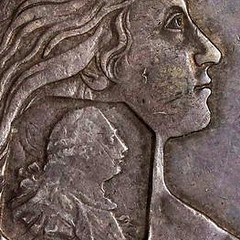 It is important to note that most examples of the Bank of England countermarked issues are primarily found on Spanish colonial mint Dollars (8 Reales). Occasionally Spanish mints or other European countries can be found with few other host types known. By all accounts the present piece as a 1798 small eagle reverse Dollar appears to be UNIQUE, with all other examples traced with the octagonal countermark are the large eagle reverse of 1798 (British Museum) or 1799 (The Bank of England, Norweb, Lord Hamilton/Whetmore and Sinton Collections). Both the Bank of England and British Museum collections do contain examples of the oval countermarks also on a small eagle dollars, but the later is an electrotype of a 1795 that was acquired in 2004 by famous author and collector Harrington E Manville.
It is important to note that most examples of the Bank of England countermarked issues are primarily found on Spanish colonial mint Dollars (8 Reales). Occasionally Spanish mints or other European countries can be found with few other host types known. By all accounts the present piece as a 1798 small eagle reverse Dollar appears to be UNIQUE, with all other examples traced with the octagonal countermark are the large eagle reverse of 1798 (British Museum) or 1799 (The Bank of England, Norweb, Lord Hamilton/Whetmore and Sinton Collections). Both the Bank of England and British Museum collections do contain examples of the oval countermarks also on a small eagle dollars, but the later is an electrotype of a 1795 that was acquired in 2004 by famous author and collector Harrington E Manville.
Mr. Manville, one of the previous owners of the present example, was a highly respected and revered academic collector of countermarked dollars of England, Scotland and Ireland. His excellent book "Tokens of the Industrial Revolution" remains to be the standard reference on the subject of merchant countermarks, but only briefly touches on Bank of England issues. For a more detailed account of the operations surrounding the Bank of England countermarked coinage Mr. E.M. Kelly author of "Spanish Dollars and Silver Tokens" offers a reasonable explanation.
According to Kelly, The Bank of England sent bags of 1,000 troy ounces of coins to the mint to be countermarked rather than specific Dollar amounts. Apparently, the bank was not particular about what the bags contained as long as the were the prescribed even weight of 1,000 ounces. Though the minors that carry these marks are considered by some to be spurious in nature, the most logical reason why so many exist today was to make up the weight deficiency. Unfortunately, the neither the mint or the bank kept records of each type or denomination that was countermarked.
To read the complete lot description, see:
GREAT BRITAIN. Great Britain - United States of America. Dollar (5 Shillings), ND (1804). Geroge III. PCGS EF-40.
(https://auctions.stacksbowers.com/lots/view/3-17B76R/great-britain-great-britain-united-states-of-america-dollar-5-shillings-nd-1804-geroge-iii-pcgs-ef-40)
1859-O DOLLAR IN INDIAN TRADE NECKLACE
There's an interesting item in the upcoming Numismatic Auctions LLC sale. Owner Steve Davis sent this preview at my request. Thanks! -Editor
Lot 104: US 1859-O Seated Dollar, Toned EF on a Native American Indian Trade Necklace. Pierced at 12 o'clock for suspension, strung(restored/restrung) with twine alongside 16 coyote teeth and numerous trade beads/baubles and more with nice overall patina, accompanied by a vintage stone arrowhead. All housed in an old, worn, stained, vintage Riker style frame with a swath of purple velvet backing fabric. Really cool appearance and a desirable piece. Great for display. Nice crossover item for the fur trade or Native American Indian collector, as well as the Seated Dollar enthusiast.
Steve adds:
"The glass is really aged and foggy in the old Riker frame. I shot the contents without glass for greater detail.
"This is kind of a wild piece, I showed it to a couple regional Native American guys who believe it could be a legit trade item. If you examine the area where the loop rides through the coin, there is definitive wear where the loop has contacted the coin from carry or being worn and toning streaks on the reverse, this likely occurred over a long period of time from all appearances.
"I am not an expert on these types of things by any means, but I certainly like it, should be fun to see where this one ends up!"
For more information, see:
https://numismaticauctionsllc.com/
1920 ZANZIBAR 1 RUPEE SPECIMEN NOTE
Stack's Bowers Director and Senior Numismatist Dr. Kelvin Cheung published a piece about a rare specimen note of Zanzibar. -Editor
Stack's Bowers Galleries proudly presents a Zanzibar 1 Rupee Specimen note dated 1920 in the January 2024 NYINC Auction. Graded PMG 64 Choice Uncirculated, it is the finest graded example of any Zanzibar 1 Rupee in either specimen or issued form. It is sure to attract strong interest in the notaphilic world when it crosses the auction block as lot 60505 on Saturday, January 13 in New York City.
The Zanzibari Rupee, valued on par with the Indian Rupee, circulated from 1908 to December 31, 1935. It replaced the Zanzibari Riyal, which circulated from 1882 to 1908, at the rate of 2-1/8 Rupee to one Riyal. The Zanzibari Rupee was in turn replaced by the East African Shilling at the rate of 1.5 Shillings to 1 Rupee.
Banknotes in denominations of 5, 10, 20, and 100 Rupees were issued in 1908, followed by the 50 and 500 Rupees notes in 1916 and finally the 1 Rupee in 1920. The notes were virtually all redeemed in 1936 and all are extremely rare with only a few issued notes in the lower denominations extant.
Stack's Bowers Galleries has a rich history with Zanzibar notes. We sold the finest known issued 5 Rupees graded VF-35 in the 2017 NYINC auction for a staggering $129,500. We also famously brokered a specimen set for a fantastic sum in the same year. It should be noted that the 2017 set did not include the 1 Rupee as it came from a Waterlow and Sons source, while the 1 Rupee was printed by Thomas De La Rue.
Zanzibar has always fascinated me, from an early age when I was an avid reader of One Thousand and One Nights, to when I was a young adult and took an interest in vintage paper money. To me, these Zanzibar notes are as ethereal and mythical as the famous story, due to their rarity and enormous value!
To read the complete article, see:
A ZANZIBAR 1 RUPEE SPECIMEN NOTE FEATURED IN NYINC WORLD PAPER MONEY AUCTION
(https://stacksbowers.com/a-zanzibar-1-rupee-specimen-note-featured-in-nyinc-world-paper-money-auction/)
To read the complete lot description, see:
ZANZIBAR. British Administration. 1 Rupee, 1920. P-1s. Specimen. PMG Choice Uncirculated 64. Uniface.
(https://auctions.stacksbowers.com/lots/view/3-177CZA/zanzibar-british-administration-1-rupee-1920-p-1s-specimen-pmg-choice-uncirculated-64-uniface)
THE BOOK BAZARRE
ISRAEL DROPS FAKE MONEY ON GAZA
Propaganda currency is used in nearly every war to gain civilian attention. Israel is using lookalike banknotes to solicit information on hostages. Found via News & Notes from the Society of Paper Money Collectors (Volume IX, Number 27, December 19, 2023). -Editor
The Israel Defense Forces are dropping counterfeit cash in Gaza, asking residents to provide information about hostages held by Hamas in exchange for a real financial reward
The fake bills, part of a multi-faceted strategy of using money to extract information from residents of Gaza, were dropped on the neighborhoods of Al-Darraj and Tuffah, a district in Gaza City, according to photos of the bills posted by Sapir Lipkin, an N12 News reporter.
To the residents of Al-Darraj and Tuffah, Hamas' ruling will not last longer! Save yourselves from the harm caused by Hamas! Your future is in your hands. This is your last chance to provide us with any information about hostages and to make sure you have a better future for yourselves and a financial reward,
read the Arabic texts on the fake 200 Shekel bill.
On the other side of the banknote, the IDF urged residents to report information to Israeli forces on the ground or by calling the telephone number written on the fake bill.
Around 120 Israelis are believed to still be held in captivity in Gaza, Israeli media reports.
To read the complete article, see:
Israel Drops Fake Money on Gaza, Promises Real Money in Exchange for Info on Hostages
(https://themessenger.com/news/israel-drops-fake-money-on-gaza-promises-real-money-in-exchange-for-info-on-hostages)
THE KING OF SILENT ANIMATION
OTHER HOBBY ROUNDUP: Collectors are a breed unto themselves, and numismatists have a kinship with collectors of all stripes, often collecting themselves in multiple areas. Here are a few recent stories about other collecting fields, starting with a New York Times piece about the "king of silent animation". Here's an excerpt. -Editor

Guess you could say I hoard,
said Tommy José Stathes as he maneuvered around the shelves of his storage unit. Large enough to accommodate a minivan, it was stuffed with thousands of film canisters stacked floor to ceiling, arranged by studio and labeled with Sharpie. Bray: Farmer Alfalfa Sees New York,
one read. Another said: Fleischer: Adventures of Popeye (1935).
Oh,
he muttered absently as he paused before a tower of brass movie cans, what do we have here?
Once a week, Mr. Stathes heads from his small studio apartment in Queens to his enormous collection of vintage cartoons: a celluloid library of around 4,000 reels, some of the prints more than 100 years old. It is certainly one of the largest collections of early animated films anywhere in the world — and that accounts for the holdings of the Library of Congress, according to an archivist who does restoration there.
His devotion to silent cartoons — the very birth of the form — is unrivaled. In fact, he has helped the Library of Congress identify some of its own collection. George Willeman, who oversees the nitrate film vaults for the library, recalled being amazed when Mr. Stathes, then in his 20s, took a seat in the archive and identified reel after reel of unidentified cartoons made decades before he was even born.
As far as I know,
Mr. Willeman said, Tommy is the king of silent animation.
As for how much his archive is worth today, Mr. Stathes is reluctant to venture a guess. Films don't have standardized valuations like coins or other regularly traded collectibles,
he said. It's a very niche, specialized field concerning objects that are more utilitarian than anything else.
To read the complete article, see:
You Need Felix the Cat? Early Popeye? Talk to the King of Silent Animation.
(https://www.nytimes.com/2023/12/19/nyregion/stathes-vintage-cartoons.html)
THE $100,000 GOODWILL STORE VASE
This one has really gone viral this week - the $3.99 Goodwill store purchase worth $100,000. It's also a story of condition, condition, condition - the vase would have been worth far less with a single scratch or chip. Another New York Times piece. Here's an excerpt. -Editor
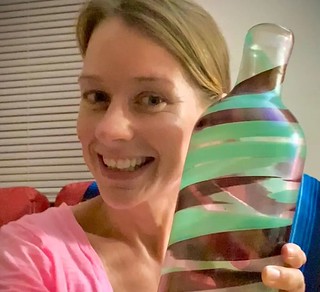 Jessica Vincent made her way in June through a busy Goodwill thrift store in Hanover County, Va., passing VCRs, lamps and glassware commonly sold at big-box retailers. Nothing really caught her eye until she saw an iridescent glass vase.
Jessica Vincent made her way in June through a busy Goodwill thrift store in Hanover County, Va., passing VCRs, lamps and glassware commonly sold at big-box retailers. Nothing really caught her eye until she saw an iridescent glass vase.
There was no price on the vase. Ms. Vincent, 43, told herself she'd pay $8.99 and no more. When the cashier rang her up, it was $3.99.
When she returned home from the Goodwill thrift store in June, she joined Facebook groups for glass identification to learn more about the vase. Some members told her it looked like it was designed by Carlo Scarpa, a renowned Italian architect, and they referred her to Wright Auction House.
On Wednesday, the vase was auctioned for $107,100 to an unidentified private art collector in Europe. About $83,500 went to Ms. Vincent and about $23,600 went to Wright Auction House.
Specialists who evaluated the piece determined it was part of the Pennellate
series that Mr. Scarpa designed in the 1940s. It's unclear how many vases of this kind were made, Mr. Wright said.
He said he was most impressed with the pristine condition of the glass.
If it had a chip — even a small chip — it would have probably sold for under $10,000,
he said. This was like a winning lottery ticket.
Ms. Vincent said she's been visiting thrift stores with her mother since she was a girl and has developed an eye for hidden treasures over the years. Ms. Vincent also said that she is an avid Antiques Roadshow
fan and loves to research her purchases.
This also shows the value of research. While I'd never trust the internet for valuation advice, it's a great way to connect with the appropriate experts. -Editor
To read the complete article, see:
Vase Bought at Goodwill for $3.99 Sells for More Than $100,000
(https://www.nytimes.com/2023/12/17/us/goodwill-vase-auction-carlo-scarpa.html)
THE WILD RIDE OF COLLECTIBLES
Finally, here's the inevitable downer report from NPR's Marketplace about the slowing of the pandemic-fueled hot market for collectibles. -Editor
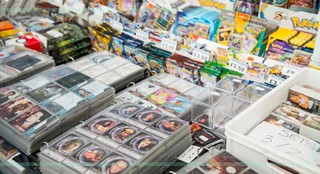 Stocks, bonds, real estate and other mainstream investments get a lot of attention in financial media. But there's also an entire world of niche investments people park their money in — think collectibles, wine, art and other alternatives to the mainstream options.
Stocks, bonds, real estate and other mainstream investments get a lot of attention in financial media. But there's also an entire world of niche investments people park their money in — think collectibles, wine, art and other alternatives to the mainstream options.
Marketplace interviewed a few of these investors back in 2019. Today, many of those same investors say the pandemic has caused them to re-think whether those investments are worth it.
About 13 years ago, Nate Tobik was helping his parents move out of their old house. He and his wife were about to have their first kid, so he pulled some of his old Lego sets out of the attic. Over the next few years, Tobik and his family started putting those sets together.
[We] started to look up missing pieces on eBay, and realized these things were going for a lot of money,
Tobik said.
Some of them were going for hundreds of dollars. Tobik said he saw a Lego train set with a crane on it that was going for over $1,000. He started buying up cheap Lego sets from local garage sales and thrift stores, and he'd sell them online — typically for double what he paid, at minimum.
People also realized how valuable their Legos were, and as they saw prices go up, they started selling their Legos for more, too. Suddenly, Tobik's buy-low and sell-high investment strategy no longer worked.
We couldn't find anything at a deep enough discount to where we could sell it again, and lock in a profit,
Tobik said.
The same thing happened with the fantasy card game Magic: The Gathering, which has a strong secondary market for individual cards.
Seth Robertson has been playing the game for years, and he'd often buy up one or two extra boxes of cards hoping they'd appreciate in value. When the pandemic hit, card values skyrocketed.
I remember seeing cards worth dollars going up to tens of dollars,
Robertson said. It's like the penny stocks of the collectible world.
The cards that I bought mid to late pandemic have all come down in value,
Robertson said.
If you're interested in artwork, it's the time to buy right now,
said Mike Kraus, an artist in Rochester, New York who's been investing in art for around 25 years.
Kraus said galleries and art fairs basically shut down when the pandemic started, and many have struggled ever since. That's meant that a lot of art just isn't selling.
There's a glut of artwork to be had,
Kraus said. I've been able to buy some pieces at very reasonable rates.
Collectible markets are purely supply and demand driven, a classic example of economics at work. Demand up, prices up. Prices up, supply up. Supply up, prices back down. Rinse and repeat.
Of course, truly rare and important items usually remain rare and important and hold more value regardless of the state of the larger market. Condition remains hugely important as well - collectors will always prefer pieces in higher condition for their collections. And despite the ups and downs of the market, collectors remain, with new ones being born every day. Curiosity is part of being human. -Editor
To read the complete article, see:
Alternative investments went on a wild ride during the pandemic
(https://www.marketplace.org/2023/12/19/alternative-investments-went-on-a-wild-ride-during-the-pandemic/)
Perhaps little Hot Wheels cars are the next big thing:
Remember those Hot Wheels you had as a kid? They're still popular and worth a fortune now.
(https://www.usatoday.com/story/graphics/2023/12/21/hot-wheels-collector-popular-55-years/71877707007/)
JENNY LIND AND SWIFT-MANIA
Scott Miller published an American Numismatic Society Pocket Change blog article on the echoes of the 19th century Jenny Lind mania in the Taylor Swift frenzy today. -Editor
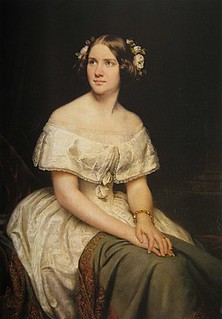 Earlier this year, the news media widely reported issues that arose with tickets to concerts to be given by the singer Taylor Swift. Coverage was given to the frustrations experienced by many fans trying to obtain tickets to her performances, as well as to their extreme devotion to the singer. This is nothing new. For most of the twentieth century, popular singers were idolized by their young fans, often to the bewilderment, or chagrin of their parents. It seems that every ten or twenty years a new figure emerged: Rudy Vallée, Frank Sinatra, Elvis Presley, the Beatles, and most recently Taylor Swift. The nineteenth century was no exception to this, though one figure stands high above the rest — Jenny Lind.
Earlier this year, the news media widely reported issues that arose with tickets to concerts to be given by the singer Taylor Swift. Coverage was given to the frustrations experienced by many fans trying to obtain tickets to her performances, as well as to their extreme devotion to the singer. This is nothing new. For most of the twentieth century, popular singers were idolized by their young fans, often to the bewilderment, or chagrin of their parents. It seems that every ten or twenty years a new figure emerged: Rudy Vallée, Frank Sinatra, Elvis Presley, the Beatles, and most recently Taylor Swift. The nineteenth century was no exception to this, though one figure stands high above the rest — Jenny Lind.
Although little is known about her by the general public today, Jenny Lind was one of the most celebrated and popular singers in the mid-nineteenth century, with a world-wide following that could only be thought of in terms of her modern counterparts. Generally known as the Swedish Nightingale, Jenny Lind was brought to the United States for a series of concerts by P. T. Barnum, whose Museum was a popular attraction in lower Manhattan. Although he had never actually heard her sing, Barnum offered Miss Lind a very generous contract based solely on her reputation as an artiste and public benefactor. News of the concert tour was first published in the American newspapers on February 11, 1850. The contract called for 150 concerts for which Barnum would pay Lind $1000 each, plus expenses, which included a companion, her accompanist and conductor, Julius Benedict, and the baritone Giovanni Belletti.
Thanks to the skills of the master promoter, Barnum began placing letters and other notices in newspapers announcing the upcoming visit by a lady whose vocal powers have never been approached by any other human being, and whose character is charity, simplicity, and goodness personified.
Barnum also stressed Miss Lind's charitable works, and that she would be allowed to hold additional concerts for that purpose. Curious as it may seem, Barnum's pronouncements were actually low-key in comparison to some others. On February 16, the New-York Semi-Weekly Tribune reported that the Realm of Song is agitated with the delightful news that the Northern Nightingale is positively coming to America; the hearts of all true worshipers at the shrine of Genius and Virtue are made glad by the hope of her advent; the music dealers will soon wear no livery but that of this Queen of Song, and no notes will pass at par unless endorsed by Jenny Lind.
On September 1, 1850, Jenny Lind arrived in New York to a crowd of thousands and decorations that included two triumphal arches, whose appearance was admittedly the work of the great showman. That evening, Lind was treated to a performance outside her hotel by two hundred musicians from the New York Musical Fund Society, who were escorted by a torchlight parade of three hundred firemen. Lind's first concert took place at Castle Garden on September 11. Most of the tickets for the first concert were sold at an auction held September 7, 1850 at the Castle. Some 3,000 people reportedly paid a twenty five cent admission fee to the auction venue, though quite a few were only there for the entertainment of watching the sale. The first ticket was sold for the astounding price of $225 to the well-known Broadway hatter Mr. Genin, who received substantial publicity as a result. The next thousand seats sold for between $10 and $25, after which the remaining five thousand brought an average of $4, still a significant amount in 1850. Curiously, the highest price bid for a ticket was for her concert in Providence, R.I., by a Col. Ross, who paid $650 and then failed to attend the performance!
The entire country was caught up in what the newspapers regularly referred to as Lind-Mania. One Boston newspaper quoted the New York Express as saying the nightingale is to lead the ton in the fashionable world, and that nothing will do this season except Jenny Lind blondes, and Jenny Lind berthas, Jenny Lind watches and Jenny Lind chains, Jenny Lind shoes and Jenny Lind petticoats, Jenny Lind hats and head-dresses, and Jenny Lind body-dresses, and a new article called Jenny Lind wrappers.
Numismatically, Jenny Lind is well represented in a variety of items, including appearances on several private banknotes. One of these was issued by the Pequonnock Bank of Bridgeport, Connecticut. Since Barnum was president of the bank, it should come as no surprise that at least one of its notes would include vignettes of Barnum, Lind, and his mansion, Iranistan. These notes proved popular with the public, but in a way that would make any collector today cringe. On February 6, 1852, The Schenectady Reflector reported that so many of Barnum's bills were mutilated by having the portraits cut off, that the directors of a local bank announced they would refuse all bills with the ends torn.
Lind also appeared on a number of medals, with 32 pieces described in a monograph by Leonidas Westerveldt entitled The Jenny Lind Medals and Tokens,
published by the The American Numismatic Society in 1921.
To read the complete article, see:
Jenny Lind and Swift-Mania
in Nineteenth-Century America
(https://numismatics.org/pocketchange/miller-lind/)
To read the earlier E-Sylum articles, see:
TAYLOR SWIFT AND NUMISMATICS
(https://www.coinbooks.org/v26/esylum_v26n47a12.html)
NOTES FROM E-SYLUM READERS: NOVEMBER 26, 2023 :
Taylor Swift and Jenny Lind
(https://www.coinbooks.org/v26/esylum_v26n48a15.html)
LOOSE CHANGE: DECEMBER 24, 2023
Here are some additional items in the media this week that may be of interest. -Editor
We may be getting closer to learning what coins and other treasures are in the wreck of the San Jose. -Editor
 The Colombian government said Thursday it will try to raise objects from the 1708 shipwreck of the galleon San Jose, which is believed to contain a cargo worth billions of dollars.
The Colombian government said Thursday it will try to raise objects from the 1708 shipwreck of the galleon San Jose, which is believed to contain a cargo worth billions of dollars.
The 300-year-old wreck, often called the holy grail of shipwrecks,
has been controversial, because it is both an archaeological and economic treasure.
But the ship is believed to hold 11 million gold and silver coins, emeralds and other precious cargo from Spanish-controlled colonies, which could be worth billions of dollars if ever recovered.
To read the complete article, see:
Colombia will try to raise objects from a 1708 shipwreck believed to have a cargo worth billions
(https://www.nashuatelegraph.com/top-headlines/2023/12/22/colombia-will-try-to-raise-objects-from-a-1708-shipwreck-believed-to-have-a-cargo-worth-billions/)
To read earlier E-Sylum articles, see:
FINDING SHIPWRECKS IS GETTING EASIER AND HARDER
(https://www.coinbooks.org/esylum_v18n49a27.html)
SPANISH GALLEON SAN JOSE FOUND
(https://www.coinbooks.org/v21/esylum_v21n22a38.html)
There's a great example of money-folding in this totally non-numismatic article about the properties of a unique geometric shape called the einstein.
-Editor
It's been a year of endless einsteins. In March, a troupe of mathematical tilers announced that they had discovered an aperiodic monotile,
a shape that can tile an infinite flat surface in a pattern that does not repeat — einstein
is the geometric term of art for this entity.
Now, the results are in from a contest run by the National Museum of Mathematics in New York and the United Kingdom Mathematics Trust in London, which asked members of the public for their most creative renditions of an einstein. A panel of judges assessed 245 submissions from 32 countries. Three winners were chosen, and, on Tuesday, there will be a ceremony at the House of Commons in London. (Each winner receives an award of 5,000 British pounds; nine finalists receive 1,000 pounds.)
Spend it
To read the complete article, see:
What Can You Do With an Einstein?
(https://www.nytimes.com/2023/12/10/science/mathematics-tiling-einstein.html)
OTIS KAYE'S HOLIDAY TREE OF MONEY
Steve Roach published a Coin World article about Sotheby's private offering of a work of money art by Otis Kaye - see the link below to read it. Here's some information from the brochure. -Editor
OTIS KAYE
(1885 - 1974)
Seasons Greetings II
signed O. Kaye (multiple times within the image)
oil on canvas mounted on board
39? by 32 in.
100.3 by 81.3 cm.
Executed in 1969.
PROVENANCE
The artist
Paul Banks II, Chicago,a cousin of the artist (a gift from the above)
Thence by descent to the present owner
EXHIBITED
New Britain, Connecticut, New Britain Museum of American Art,
Otis Kaye: Money, Mystery,and Mastery, 2015,
n.n., p.124,p.125,illustrated in color
To read the complete article, see:
Otis Kaye's holiday tree of money offered by Sotheby's
(https://www.coinworld.com/news/us-coins/otis-kaye-s-holiday-tree-of-money-offered-by-sotheby-s)
To read the earlier E-Sylum articles, see:
BOOK REVIEW: OTIS KAYE
(https://coinbooks.org/v23/esylum_v23n28a06.html)
OTIS KAYE (1885-1974)
(https://www.coinbooks.org/v25/esylum_v25n35a22.html)
OTIS KAYE'S COIN COLLECTION
(https://www.coinbooks.org/v26/esylum_v26n08a30.html)


